Leadership Styles and Personal Development Planning
VerifiedAdded on 2023/01/07
|18
|5498
|71
AI Summary
This document discusses various topics related to leadership styles and personal development planning. It covers the meaning of vision, mission, and values in organizations, different leadership styles, and the methodology of personal development planning. It also elaborates on data collection methods.
Contribute Materials
Your contribution can guide someone’s learning journey. Share your
documents today.
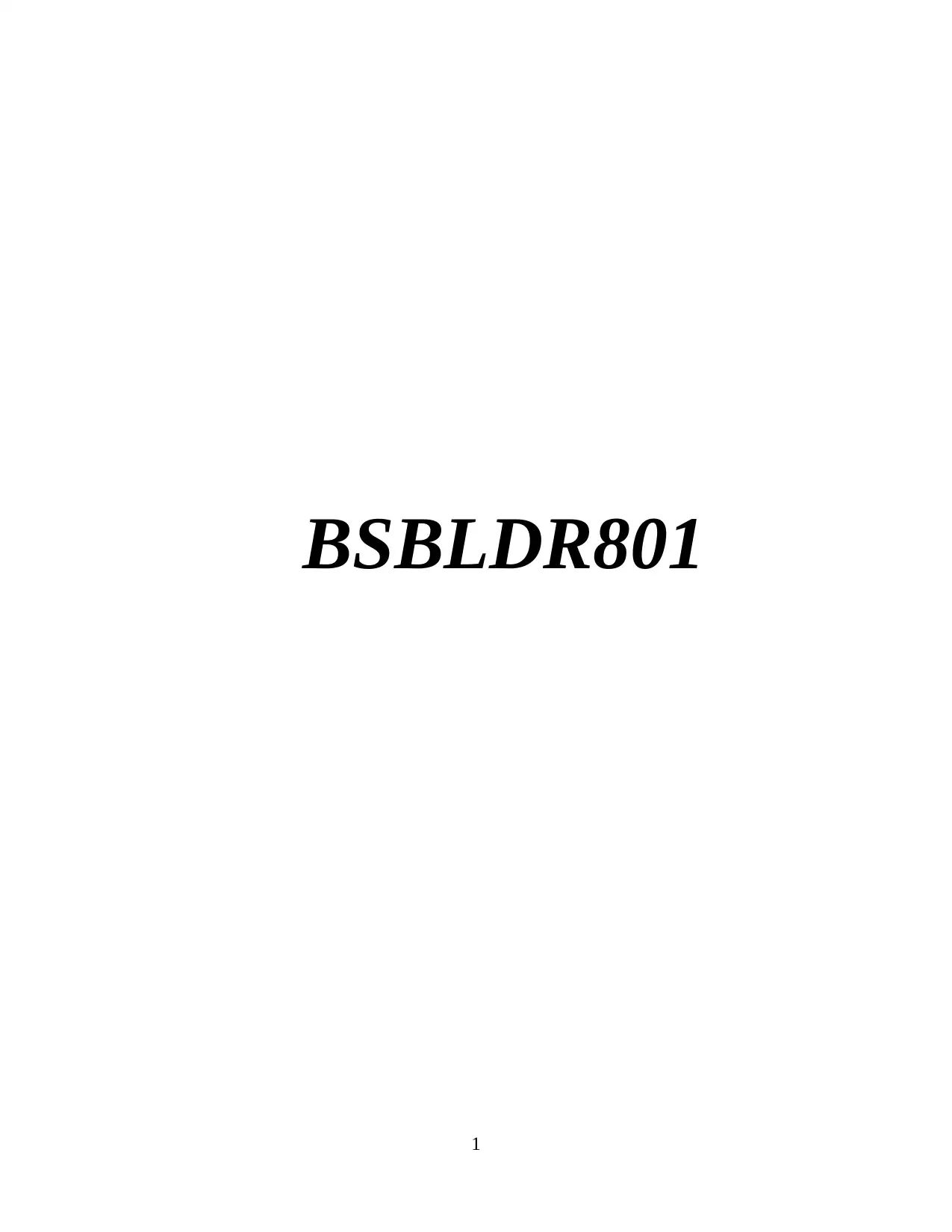
BSBLDR801
1
1
Secure Best Marks with AI Grader
Need help grading? Try our AI Grader for instant feedback on your assignments.
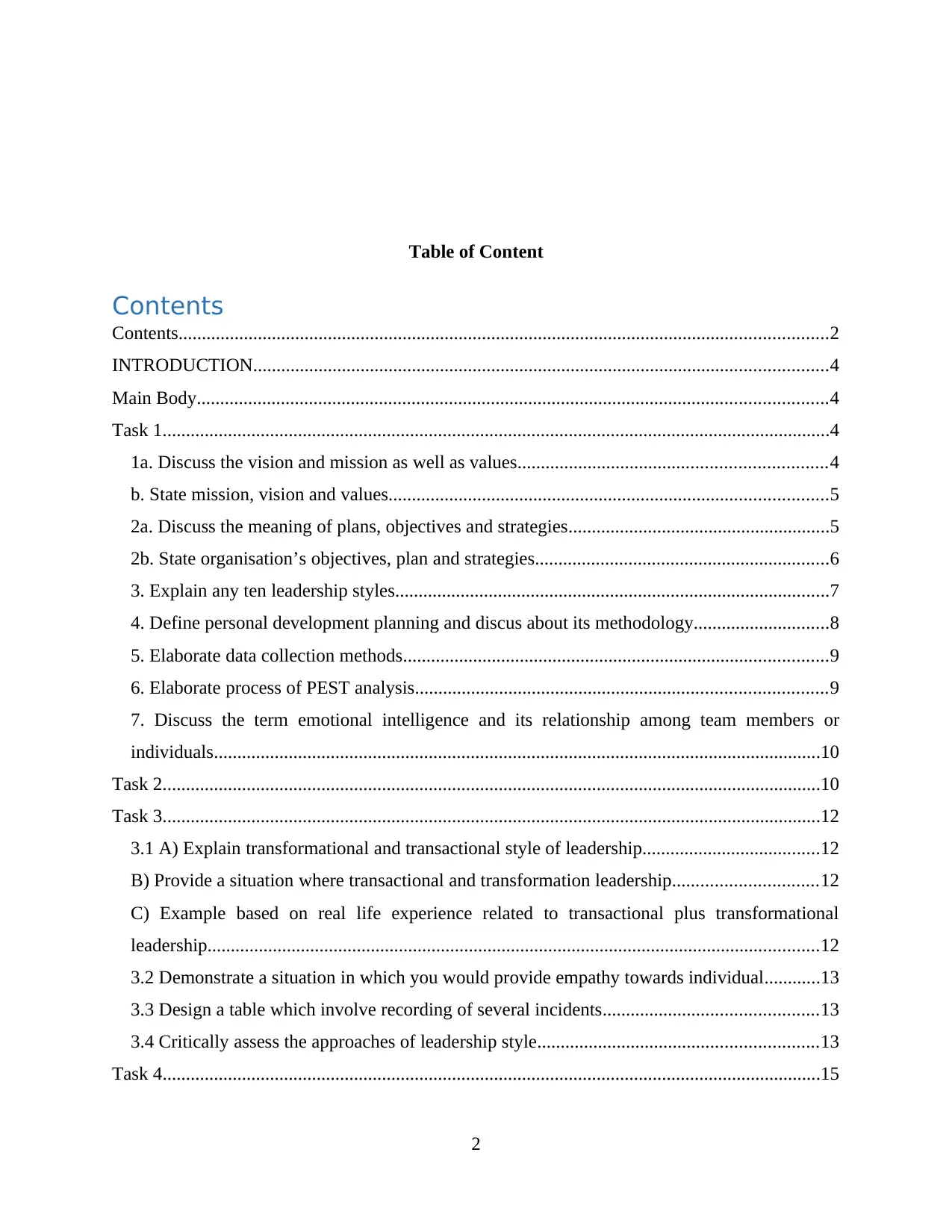
Table of Content
Contents
Contents...........................................................................................................................................2
INTRODUCTION...........................................................................................................................4
Main Body.......................................................................................................................................4
Task 1...............................................................................................................................................4
1a. Discuss the vision and mission as well as values..................................................................4
b. State mission, vision and values..............................................................................................5
2a. Discuss the meaning of plans, objectives and strategies........................................................5
2b. State organisation’s objectives, plan and strategies...............................................................6
3. Explain any ten leadership styles.............................................................................................7
4. Define personal development planning and discus about its methodology.............................8
5. Elaborate data collection methods...........................................................................................9
6. Elaborate process of PEST analysis........................................................................................9
7. Discuss the term emotional intelligence and its relationship among team members or
individuals..................................................................................................................................10
Task 2.............................................................................................................................................10
Task 3.............................................................................................................................................12
3.1 A) Explain transformational and transactional style of leadership......................................12
B) Provide a situation where transactional and transformation leadership...............................12
C) Example based on real life experience related to transactional plus transformational
leadership...................................................................................................................................12
3.2 Demonstrate a situation in which you would provide empathy towards individual............13
3.3 Design a table which involve recording of several incidents..............................................13
3.4 Critically assess the approaches of leadership style............................................................13
Task 4.............................................................................................................................................15
2
Contents
Contents...........................................................................................................................................2
INTRODUCTION...........................................................................................................................4
Main Body.......................................................................................................................................4
Task 1...............................................................................................................................................4
1a. Discuss the vision and mission as well as values..................................................................4
b. State mission, vision and values..............................................................................................5
2a. Discuss the meaning of plans, objectives and strategies........................................................5
2b. State organisation’s objectives, plan and strategies...............................................................6
3. Explain any ten leadership styles.............................................................................................7
4. Define personal development planning and discus about its methodology.............................8
5. Elaborate data collection methods...........................................................................................9
6. Elaborate process of PEST analysis........................................................................................9
7. Discuss the term emotional intelligence and its relationship among team members or
individuals..................................................................................................................................10
Task 2.............................................................................................................................................10
Task 3.............................................................................................................................................12
3.1 A) Explain transformational and transactional style of leadership......................................12
B) Provide a situation where transactional and transformation leadership...............................12
C) Example based on real life experience related to transactional plus transformational
leadership...................................................................................................................................12
3.2 Demonstrate a situation in which you would provide empathy towards individual............13
3.3 Design a table which involve recording of several incidents..............................................13
3.4 Critically assess the approaches of leadership style............................................................13
Task 4.............................................................................................................................................15
2
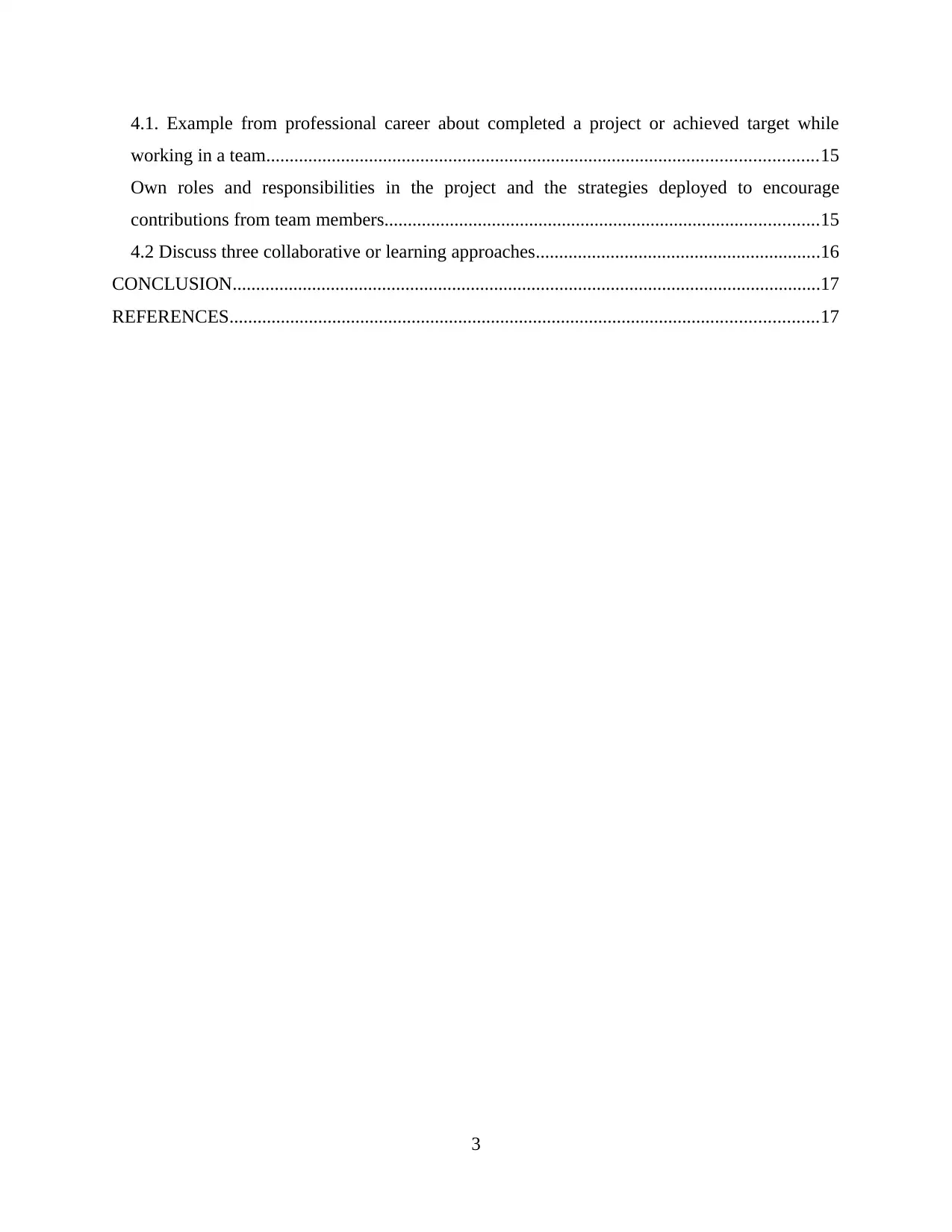
4.1. Example from professional career about completed a project or achieved target while
working in a team......................................................................................................................15
Own roles and responsibilities in the project and the strategies deployed to encourage
contributions from team members.............................................................................................15
4.2 Discuss three collaborative or learning approaches.............................................................16
CONCLUSION..............................................................................................................................17
REFERENCES..............................................................................................................................17
3
working in a team......................................................................................................................15
Own roles and responsibilities in the project and the strategies deployed to encourage
contributions from team members.............................................................................................15
4.2 Discuss three collaborative or learning approaches.............................................................16
CONCLUSION..............................................................................................................................17
REFERENCES..............................................................................................................................17
3
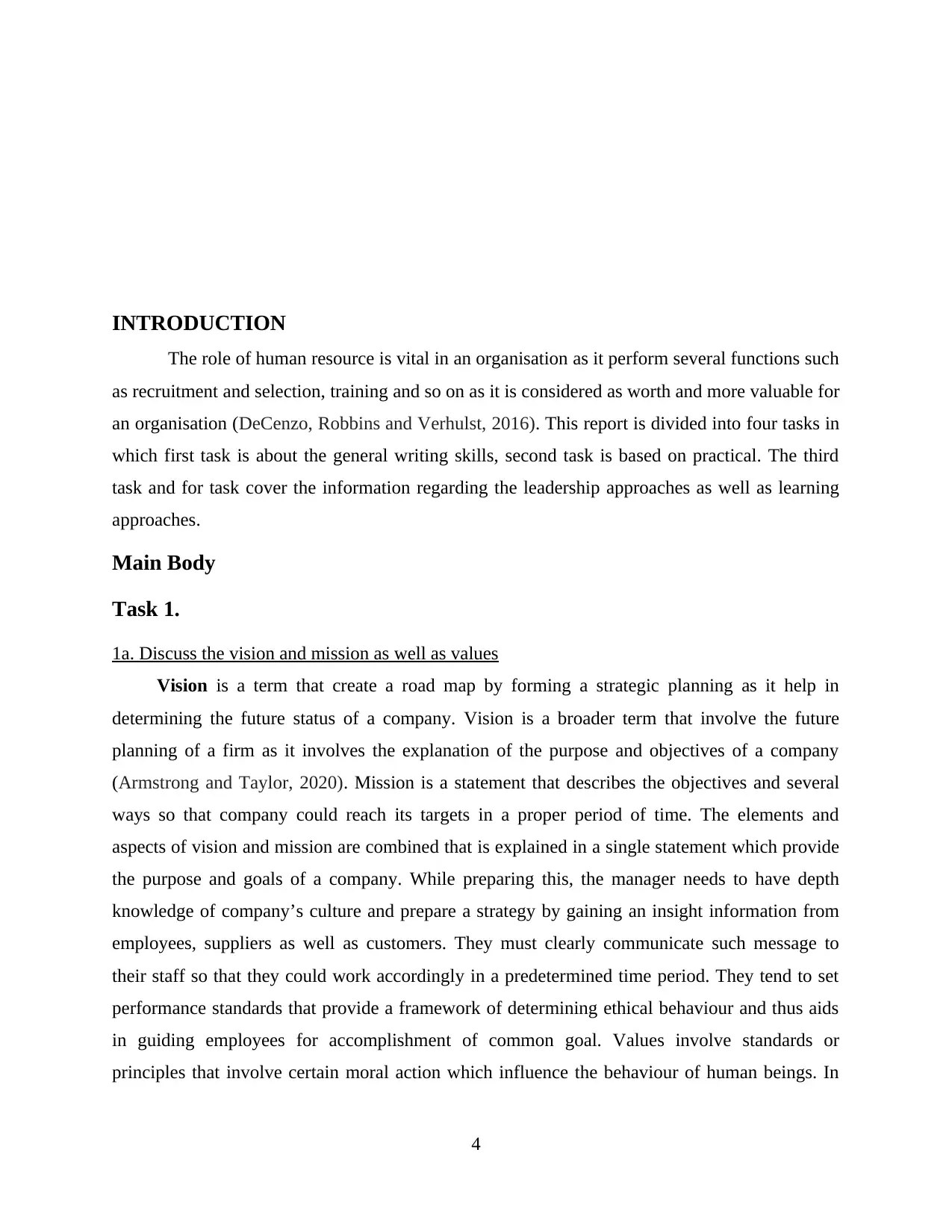
INTRODUCTION
The role of human resource is vital in an organisation as it perform several functions such
as recruitment and selection, training and so on as it is considered as worth and more valuable for
an organisation (DeCenzo, Robbins and Verhulst, 2016). This report is divided into four tasks in
which first task is about the general writing skills, second task is based on practical. The third
task and for task cover the information regarding the leadership approaches as well as learning
approaches.
Main Body
Task 1.
1a. Discuss the vision and mission as well as values
Vision is a term that create a road map by forming a strategic planning as it help in
determining the future status of a company. Vision is a broader term that involve the future
planning of a firm as it involves the explanation of the purpose and objectives of a company
(Armstrong and Taylor, 2020). Mission is a statement that describes the objectives and several
ways so that company could reach its targets in a proper period of time. The elements and
aspects of vision and mission are combined that is explained in a single statement which provide
the purpose and goals of a company. While preparing this, the manager needs to have depth
knowledge of company’s culture and prepare a strategy by gaining an insight information from
employees, suppliers as well as customers. They must clearly communicate such message to
their staff so that they could work accordingly in a predetermined time period. They tend to set
performance standards that provide a framework of determining ethical behaviour and thus aids
in guiding employees for accomplishment of common goal. Values involve standards or
principles that involve certain moral action which influence the behaviour of human beings. In
4
The role of human resource is vital in an organisation as it perform several functions such
as recruitment and selection, training and so on as it is considered as worth and more valuable for
an organisation (DeCenzo, Robbins and Verhulst, 2016). This report is divided into four tasks in
which first task is about the general writing skills, second task is based on practical. The third
task and for task cover the information regarding the leadership approaches as well as learning
approaches.
Main Body
Task 1.
1a. Discuss the vision and mission as well as values
Vision is a term that create a road map by forming a strategic planning as it help in
determining the future status of a company. Vision is a broader term that involve the future
planning of a firm as it involves the explanation of the purpose and objectives of a company
(Armstrong and Taylor, 2020). Mission is a statement that describes the objectives and several
ways so that company could reach its targets in a proper period of time. The elements and
aspects of vision and mission are combined that is explained in a single statement which provide
the purpose and goals of a company. While preparing this, the manager needs to have depth
knowledge of company’s culture and prepare a strategy by gaining an insight information from
employees, suppliers as well as customers. They must clearly communicate such message to
their staff so that they could work accordingly in a predetermined time period. They tend to set
performance standards that provide a framework of determining ethical behaviour and thus aids
in guiding employees for accomplishment of common goal. Values involve standards or
principles that involve certain moral action which influence the behaviour of human beings. In
4
Paraphrase This Document
Need a fresh take? Get an instant paraphrase of this document with our AI Paraphraser
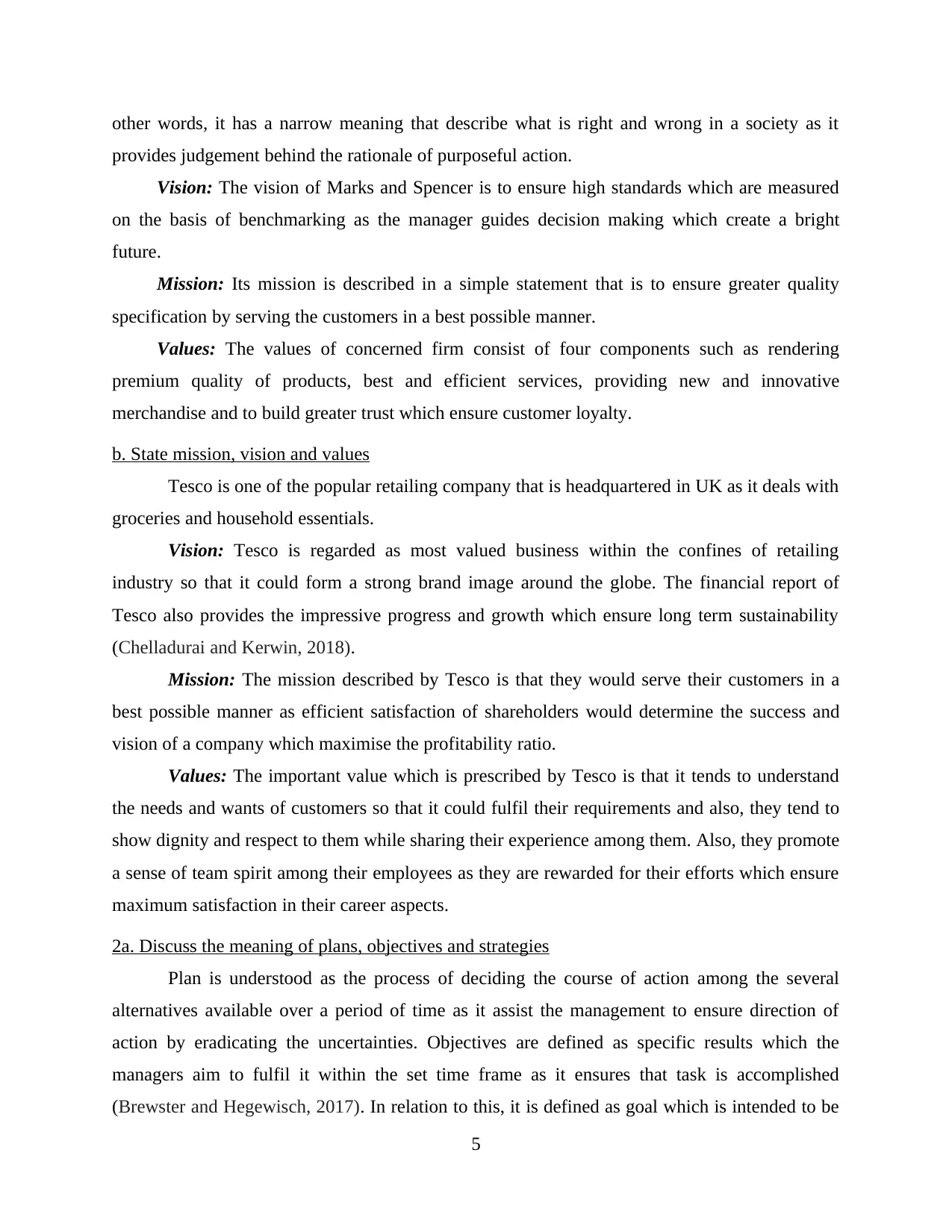
other words, it has a narrow meaning that describe what is right and wrong in a society as it
provides judgement behind the rationale of purposeful action.
Vision: The vision of Marks and Spencer is to ensure high standards which are measured
on the basis of benchmarking as the manager guides decision making which create a bright
future.
Mission: Its mission is described in a simple statement that is to ensure greater quality
specification by serving the customers in a best possible manner.
Values: The values of concerned firm consist of four components such as rendering
premium quality of products, best and efficient services, providing new and innovative
merchandise and to build greater trust which ensure customer loyalty.
b. State mission, vision and values
Tesco is one of the popular retailing company that is headquartered in UK as it deals with
groceries and household essentials.
Vision: Tesco is regarded as most valued business within the confines of retailing
industry so that it could form a strong brand image around the globe. The financial report of
Tesco also provides the impressive progress and growth which ensure long term sustainability
(Chelladurai and Kerwin, 2018).
Mission: The mission described by Tesco is that they would serve their customers in a
best possible manner as efficient satisfaction of shareholders would determine the success and
vision of a company which maximise the profitability ratio.
Values: The important value which is prescribed by Tesco is that it tends to understand
the needs and wants of customers so that it could fulfil their requirements and also, they tend to
show dignity and respect to them while sharing their experience among them. Also, they promote
a sense of team spirit among their employees as they are rewarded for their efforts which ensure
maximum satisfaction in their career aspects.
2a. Discuss the meaning of plans, objectives and strategies
Plan is understood as the process of deciding the course of action among the several
alternatives available over a period of time as it assist the management to ensure direction of
action by eradicating the uncertainties. Objectives are defined as specific results which the
managers aim to fulfil it within the set time frame as it ensures that task is accomplished
(Brewster and Hegewisch, 2017). In relation to this, it is defined as goal which is intended to be
5
provides judgement behind the rationale of purposeful action.
Vision: The vision of Marks and Spencer is to ensure high standards which are measured
on the basis of benchmarking as the manager guides decision making which create a bright
future.
Mission: Its mission is described in a simple statement that is to ensure greater quality
specification by serving the customers in a best possible manner.
Values: The values of concerned firm consist of four components such as rendering
premium quality of products, best and efficient services, providing new and innovative
merchandise and to build greater trust which ensure customer loyalty.
b. State mission, vision and values
Tesco is one of the popular retailing company that is headquartered in UK as it deals with
groceries and household essentials.
Vision: Tesco is regarded as most valued business within the confines of retailing
industry so that it could form a strong brand image around the globe. The financial report of
Tesco also provides the impressive progress and growth which ensure long term sustainability
(Chelladurai and Kerwin, 2018).
Mission: The mission described by Tesco is that they would serve their customers in a
best possible manner as efficient satisfaction of shareholders would determine the success and
vision of a company which maximise the profitability ratio.
Values: The important value which is prescribed by Tesco is that it tends to understand
the needs and wants of customers so that it could fulfil their requirements and also, they tend to
show dignity and respect to them while sharing their experience among them. Also, they promote
a sense of team spirit among their employees as they are rewarded for their efforts which ensure
maximum satisfaction in their career aspects.
2a. Discuss the meaning of plans, objectives and strategies
Plan is understood as the process of deciding the course of action among the several
alternatives available over a period of time as it assist the management to ensure direction of
action by eradicating the uncertainties. Objectives are defined as specific results which the
managers aim to fulfil it within the set time frame as it ensures that task is accomplished
(Brewster and Hegewisch, 2017). In relation to this, it is defined as goal which is intended to be
5
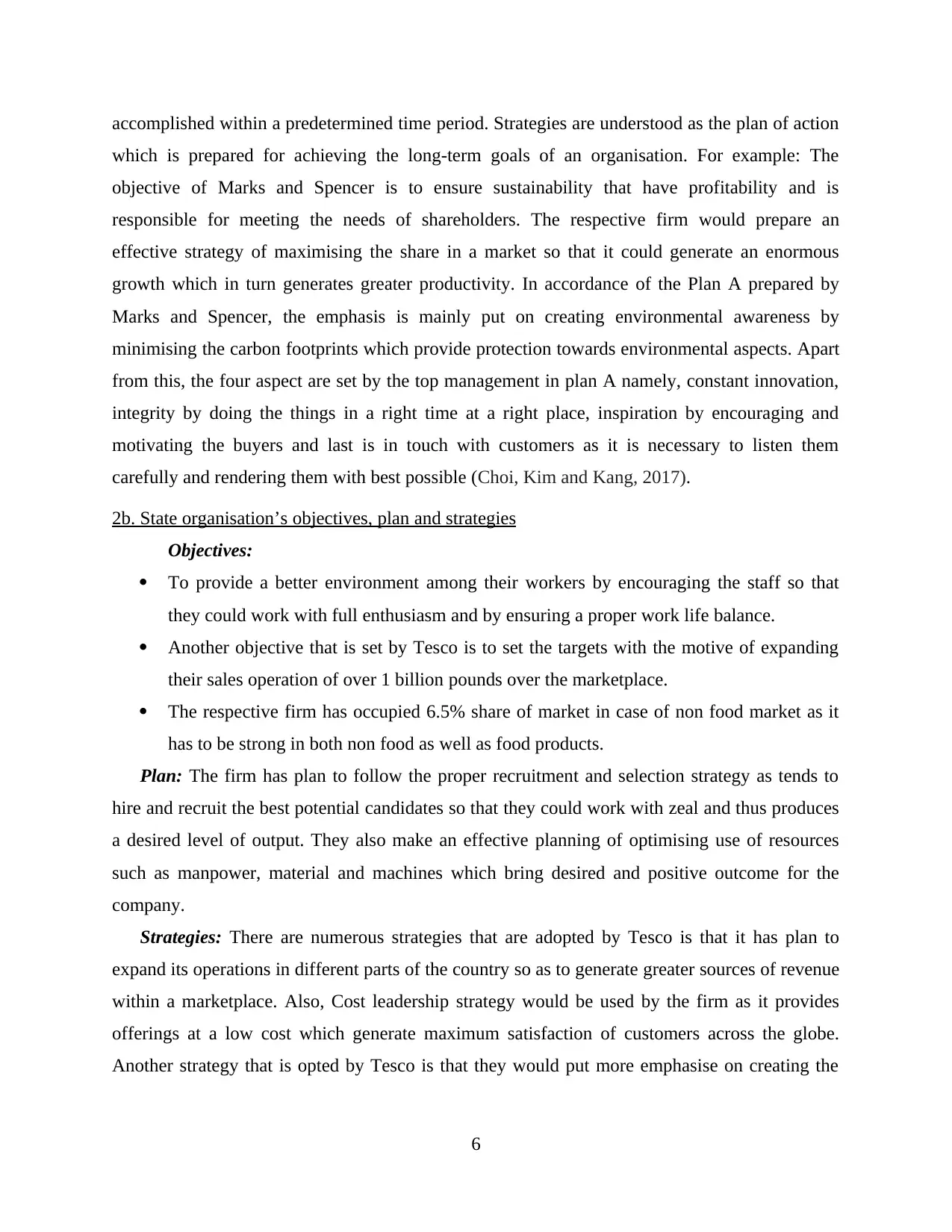
accomplished within a predetermined time period. Strategies are understood as the plan of action
which is prepared for achieving the long-term goals of an organisation. For example: The
objective of Marks and Spencer is to ensure sustainability that have profitability and is
responsible for meeting the needs of shareholders. The respective firm would prepare an
effective strategy of maximising the share in a market so that it could generate an enormous
growth which in turn generates greater productivity. In accordance of the Plan A prepared by
Marks and Spencer, the emphasis is mainly put on creating environmental awareness by
minimising the carbon footprints which provide protection towards environmental aspects. Apart
from this, the four aspect are set by the top management in plan A namely, constant innovation,
integrity by doing the things in a right time at a right place, inspiration by encouraging and
motivating the buyers and last is in touch with customers as it is necessary to listen them
carefully and rendering them with best possible (Choi, Kim and Kang, 2017).
2b. State organisation’s objectives, plan and strategies
Objectives:
To provide a better environment among their workers by encouraging the staff so that
they could work with full enthusiasm and by ensuring a proper work life balance.
Another objective that is set by Tesco is to set the targets with the motive of expanding
their sales operation of over 1 billion pounds over the marketplace.
The respective firm has occupied 6.5% share of market in case of non food market as it
has to be strong in both non food as well as food products.
Plan: The firm has plan to follow the proper recruitment and selection strategy as tends to
hire and recruit the best potential candidates so that they could work with zeal and thus produces
a desired level of output. They also make an effective planning of optimising use of resources
such as manpower, material and machines which bring desired and positive outcome for the
company.
Strategies: There are numerous strategies that are adopted by Tesco is that it has plan to
expand its operations in different parts of the country so as to generate greater sources of revenue
within a marketplace. Also, Cost leadership strategy would be used by the firm as it provides
offerings at a low cost which generate maximum satisfaction of customers across the globe.
Another strategy that is opted by Tesco is that they would put more emphasise on creating the
6
which is prepared for achieving the long-term goals of an organisation. For example: The
objective of Marks and Spencer is to ensure sustainability that have profitability and is
responsible for meeting the needs of shareholders. The respective firm would prepare an
effective strategy of maximising the share in a market so that it could generate an enormous
growth which in turn generates greater productivity. In accordance of the Plan A prepared by
Marks and Spencer, the emphasis is mainly put on creating environmental awareness by
minimising the carbon footprints which provide protection towards environmental aspects. Apart
from this, the four aspect are set by the top management in plan A namely, constant innovation,
integrity by doing the things in a right time at a right place, inspiration by encouraging and
motivating the buyers and last is in touch with customers as it is necessary to listen them
carefully and rendering them with best possible (Choi, Kim and Kang, 2017).
2b. State organisation’s objectives, plan and strategies
Objectives:
To provide a better environment among their workers by encouraging the staff so that
they could work with full enthusiasm and by ensuring a proper work life balance.
Another objective that is set by Tesco is to set the targets with the motive of expanding
their sales operation of over 1 billion pounds over the marketplace.
The respective firm has occupied 6.5% share of market in case of non food market as it
has to be strong in both non food as well as food products.
Plan: The firm has plan to follow the proper recruitment and selection strategy as tends to
hire and recruit the best potential candidates so that they could work with zeal and thus produces
a desired level of output. They also make an effective planning of optimising use of resources
such as manpower, material and machines which bring desired and positive outcome for the
company.
Strategies: There are numerous strategies that are adopted by Tesco is that it has plan to
expand its operations in different parts of the country so as to generate greater sources of revenue
within a marketplace. Also, Cost leadership strategy would be used by the firm as it provides
offerings at a low cost which generate maximum satisfaction of customers across the globe.
Another strategy that is opted by Tesco is that they would put more emphasise on creating the
6
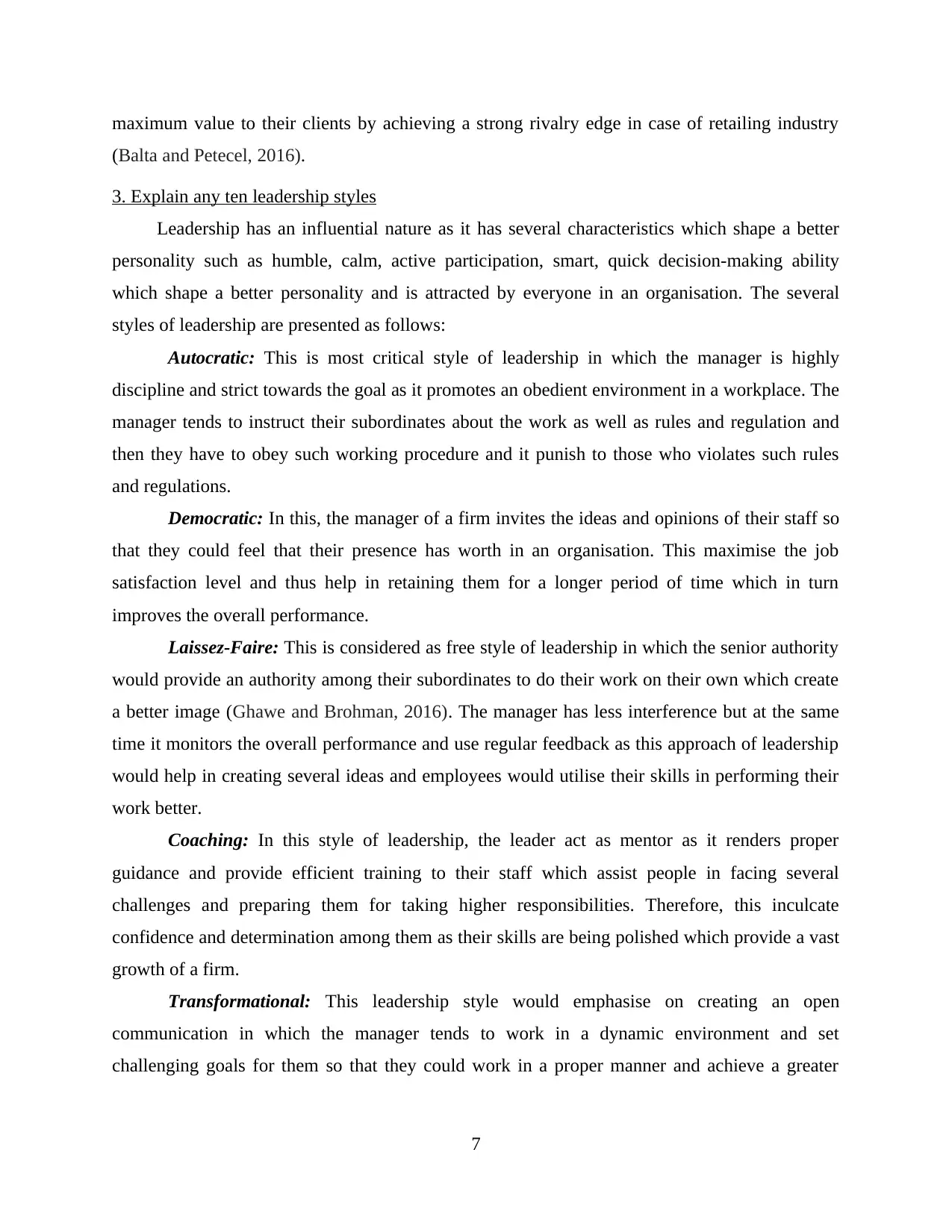
maximum value to their clients by achieving a strong rivalry edge in case of retailing industry
(Balta and Petecel, 2016).
3. Explain any ten leadership styles
Leadership has an influential nature as it has several characteristics which shape a better
personality such as humble, calm, active participation, smart, quick decision-making ability
which shape a better personality and is attracted by everyone in an organisation. The several
styles of leadership are presented as follows:
Autocratic: This is most critical style of leadership in which the manager is highly
discipline and strict towards the goal as it promotes an obedient environment in a workplace. The
manager tends to instruct their subordinates about the work as well as rules and regulation and
then they have to obey such working procedure and it punish to those who violates such rules
and regulations.
Democratic: In this, the manager of a firm invites the ideas and opinions of their staff so
that they could feel that their presence has worth in an organisation. This maximise the job
satisfaction level and thus help in retaining them for a longer period of time which in turn
improves the overall performance.
Laissez-Faire: This is considered as free style of leadership in which the senior authority
would provide an authority among their subordinates to do their work on their own which create
a better image (Ghawe and Brohman, 2016). The manager has less interference but at the same
time it monitors the overall performance and use regular feedback as this approach of leadership
would help in creating several ideas and employees would utilise their skills in performing their
work better.
Coaching: In this style of leadership, the leader act as mentor as it renders proper
guidance and provide efficient training to their staff which assist people in facing several
challenges and preparing them for taking higher responsibilities. Therefore, this inculcate
confidence and determination among them as their skills are being polished which provide a vast
growth of a firm.
Transformational: This leadership style would emphasise on creating an open
communication in which the manager tends to work in a dynamic environment and set
challenging goals for them so that they could work in a proper manner and achieve a greater
7
(Balta and Petecel, 2016).
3. Explain any ten leadership styles
Leadership has an influential nature as it has several characteristics which shape a better
personality such as humble, calm, active participation, smart, quick decision-making ability
which shape a better personality and is attracted by everyone in an organisation. The several
styles of leadership are presented as follows:
Autocratic: This is most critical style of leadership in which the manager is highly
discipline and strict towards the goal as it promotes an obedient environment in a workplace. The
manager tends to instruct their subordinates about the work as well as rules and regulation and
then they have to obey such working procedure and it punish to those who violates such rules
and regulations.
Democratic: In this, the manager of a firm invites the ideas and opinions of their staff so
that they could feel that their presence has worth in an organisation. This maximise the job
satisfaction level and thus help in retaining them for a longer period of time which in turn
improves the overall performance.
Laissez-Faire: This is considered as free style of leadership in which the senior authority
would provide an authority among their subordinates to do their work on their own which create
a better image (Ghawe and Brohman, 2016). The manager has less interference but at the same
time it monitors the overall performance and use regular feedback as this approach of leadership
would help in creating several ideas and employees would utilise their skills in performing their
work better.
Coaching: In this style of leadership, the leader act as mentor as it renders proper
guidance and provide efficient training to their staff which assist people in facing several
challenges and preparing them for taking higher responsibilities. Therefore, this inculcate
confidence and determination among them as their skills are being polished which provide a vast
growth of a firm.
Transformational: This leadership style would emphasise on creating an open
communication in which the manager tends to work in a dynamic environment and set
challenging goals for them so that they could work in a proper manner and achieve a greater
7
Secure Best Marks with AI Grader
Need help grading? Try our AI Grader for instant feedback on your assignments.
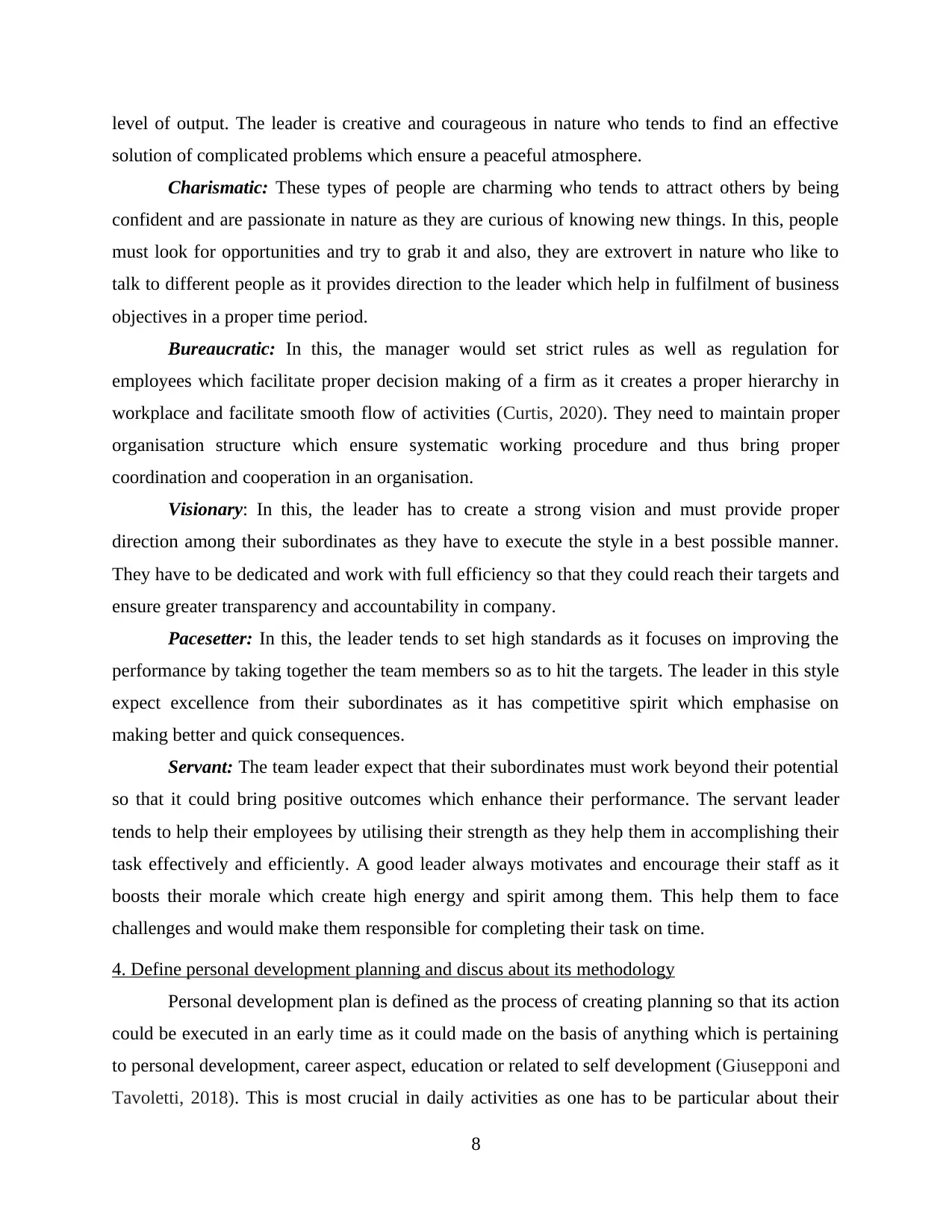
level of output. The leader is creative and courageous in nature who tends to find an effective
solution of complicated problems which ensure a peaceful atmosphere.
Charismatic: These types of people are charming who tends to attract others by being
confident and are passionate in nature as they are curious of knowing new things. In this, people
must look for opportunities and try to grab it and also, they are extrovert in nature who like to
talk to different people as it provides direction to the leader which help in fulfilment of business
objectives in a proper time period.
Bureaucratic: In this, the manager would set strict rules as well as regulation for
employees which facilitate proper decision making of a firm as it creates a proper hierarchy in
workplace and facilitate smooth flow of activities (Curtis, 2020). They need to maintain proper
organisation structure which ensure systematic working procedure and thus bring proper
coordination and cooperation in an organisation.
Visionary: In this, the leader has to create a strong vision and must provide proper
direction among their subordinates as they have to execute the style in a best possible manner.
They have to be dedicated and work with full efficiency so that they could reach their targets and
ensure greater transparency and accountability in company.
Pacesetter: In this, the leader tends to set high standards as it focuses on improving the
performance by taking together the team members so as to hit the targets. The leader in this style
expect excellence from their subordinates as it has competitive spirit which emphasise on
making better and quick consequences.
Servant: The team leader expect that their subordinates must work beyond their potential
so that it could bring positive outcomes which enhance their performance. The servant leader
tends to help their employees by utilising their strength as they help them in accomplishing their
task effectively and efficiently. A good leader always motivates and encourage their staff as it
boosts their morale which create high energy and spirit among them. This help them to face
challenges and would make them responsible for completing their task on time.
4. Define personal development planning and discus about its methodology
Personal development plan is defined as the process of creating planning so that its action
could be executed in an early time as it could made on the basis of anything which is pertaining
to personal development, career aspect, education or related to self development (Giusepponi and
Tavoletti, 2018). This is most crucial in daily activities as one has to be particular about their
8
solution of complicated problems which ensure a peaceful atmosphere.
Charismatic: These types of people are charming who tends to attract others by being
confident and are passionate in nature as they are curious of knowing new things. In this, people
must look for opportunities and try to grab it and also, they are extrovert in nature who like to
talk to different people as it provides direction to the leader which help in fulfilment of business
objectives in a proper time period.
Bureaucratic: In this, the manager would set strict rules as well as regulation for
employees which facilitate proper decision making of a firm as it creates a proper hierarchy in
workplace and facilitate smooth flow of activities (Curtis, 2020). They need to maintain proper
organisation structure which ensure systematic working procedure and thus bring proper
coordination and cooperation in an organisation.
Visionary: In this, the leader has to create a strong vision and must provide proper
direction among their subordinates as they have to execute the style in a best possible manner.
They have to be dedicated and work with full efficiency so that they could reach their targets and
ensure greater transparency and accountability in company.
Pacesetter: In this, the leader tends to set high standards as it focuses on improving the
performance by taking together the team members so as to hit the targets. The leader in this style
expect excellence from their subordinates as it has competitive spirit which emphasise on
making better and quick consequences.
Servant: The team leader expect that their subordinates must work beyond their potential
so that it could bring positive outcomes which enhance their performance. The servant leader
tends to help their employees by utilising their strength as they help them in accomplishing their
task effectively and efficiently. A good leader always motivates and encourage their staff as it
boosts their morale which create high energy and spirit among them. This help them to face
challenges and would make them responsible for completing their task on time.
4. Define personal development planning and discus about its methodology
Personal development plan is defined as the process of creating planning so that its action
could be executed in an early time as it could made on the basis of anything which is pertaining
to personal development, career aspect, education or related to self development (Giusepponi and
Tavoletti, 2018). This is most crucial in daily activities as one has to be particular about their
8
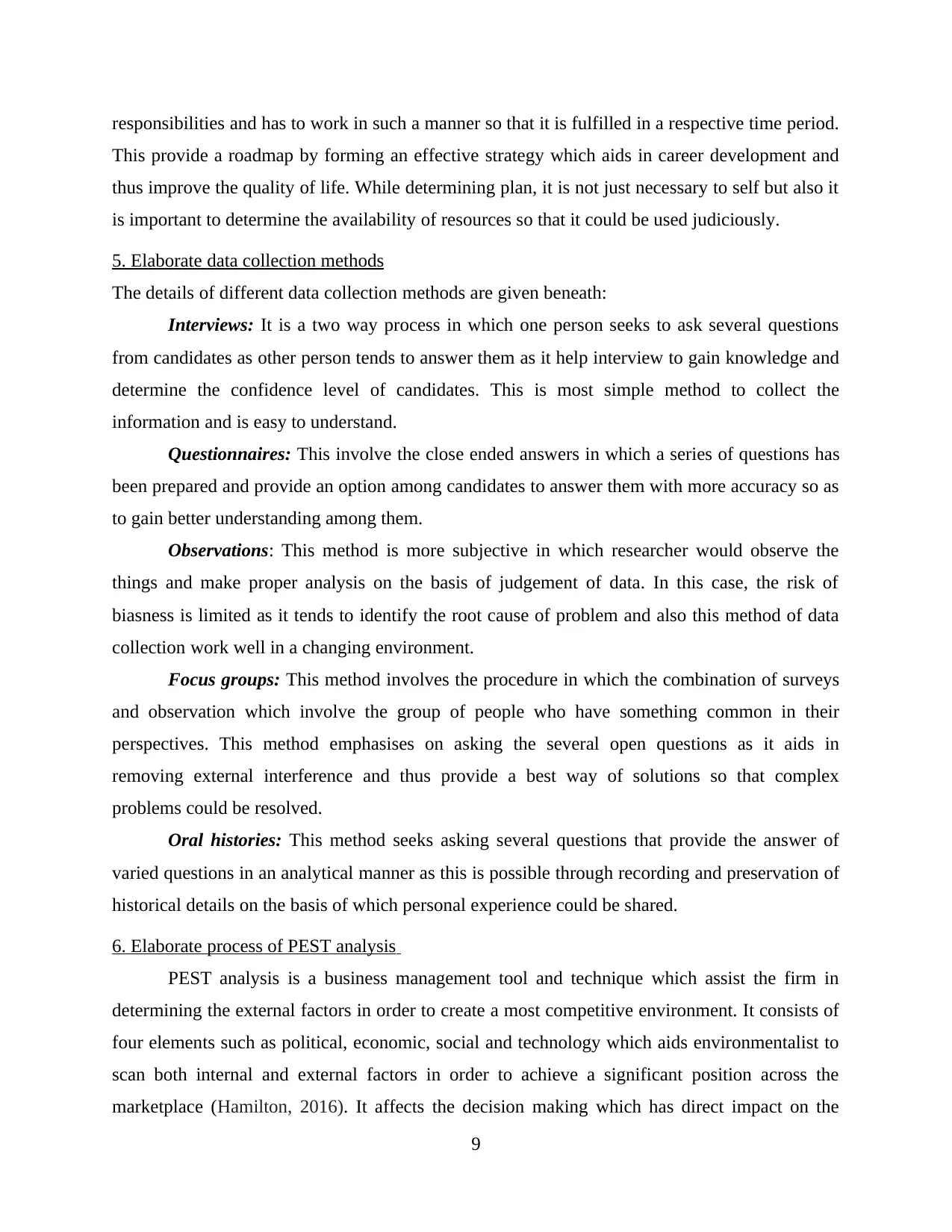
responsibilities and has to work in such a manner so that it is fulfilled in a respective time period.
This provide a roadmap by forming an effective strategy which aids in career development and
thus improve the quality of life. While determining plan, it is not just necessary to self but also it
is important to determine the availability of resources so that it could be used judiciously.
5. Elaborate data collection methods
The details of different data collection methods are given beneath:
Interviews: It is a two way process in which one person seeks to ask several questions
from candidates as other person tends to answer them as it help interview to gain knowledge and
determine the confidence level of candidates. This is most simple method to collect the
information and is easy to understand.
Questionnaires: This involve the close ended answers in which a series of questions has
been prepared and provide an option among candidates to answer them with more accuracy so as
to gain better understanding among them.
Observations: This method is more subjective in which researcher would observe the
things and make proper analysis on the basis of judgement of data. In this case, the risk of
biasness is limited as it tends to identify the root cause of problem and also this method of data
collection work well in a changing environment.
Focus groups: This method involves the procedure in which the combination of surveys
and observation which involve the group of people who have something common in their
perspectives. This method emphasises on asking the several open questions as it aids in
removing external interference and thus provide a best way of solutions so that complex
problems could be resolved.
Oral histories: This method seeks asking several questions that provide the answer of
varied questions in an analytical manner as this is possible through recording and preservation of
historical details on the basis of which personal experience could be shared.
6. Elaborate process of PEST analysis
PEST analysis is a business management tool and technique which assist the firm in
determining the external factors in order to create a most competitive environment. It consists of
four elements such as political, economic, social and technology which aids environmentalist to
scan both internal and external factors in order to achieve a significant position across the
marketplace (Hamilton, 2016). It affects the decision making which has direct impact on the
9
This provide a roadmap by forming an effective strategy which aids in career development and
thus improve the quality of life. While determining plan, it is not just necessary to self but also it
is important to determine the availability of resources so that it could be used judiciously.
5. Elaborate data collection methods
The details of different data collection methods are given beneath:
Interviews: It is a two way process in which one person seeks to ask several questions
from candidates as other person tends to answer them as it help interview to gain knowledge and
determine the confidence level of candidates. This is most simple method to collect the
information and is easy to understand.
Questionnaires: This involve the close ended answers in which a series of questions has
been prepared and provide an option among candidates to answer them with more accuracy so as
to gain better understanding among them.
Observations: This method is more subjective in which researcher would observe the
things and make proper analysis on the basis of judgement of data. In this case, the risk of
biasness is limited as it tends to identify the root cause of problem and also this method of data
collection work well in a changing environment.
Focus groups: This method involves the procedure in which the combination of surveys
and observation which involve the group of people who have something common in their
perspectives. This method emphasises on asking the several open questions as it aids in
removing external interference and thus provide a best way of solutions so that complex
problems could be resolved.
Oral histories: This method seeks asking several questions that provide the answer of
varied questions in an analytical manner as this is possible through recording and preservation of
historical details on the basis of which personal experience could be shared.
6. Elaborate process of PEST analysis
PEST analysis is a business management tool and technique which assist the firm in
determining the external factors in order to create a most competitive environment. It consists of
four elements such as political, economic, social and technology which aids environmentalist to
scan both internal and external factors in order to achieve a significant position across the
marketplace (Hamilton, 2016). It affects the decision making which has direct impact on the
9
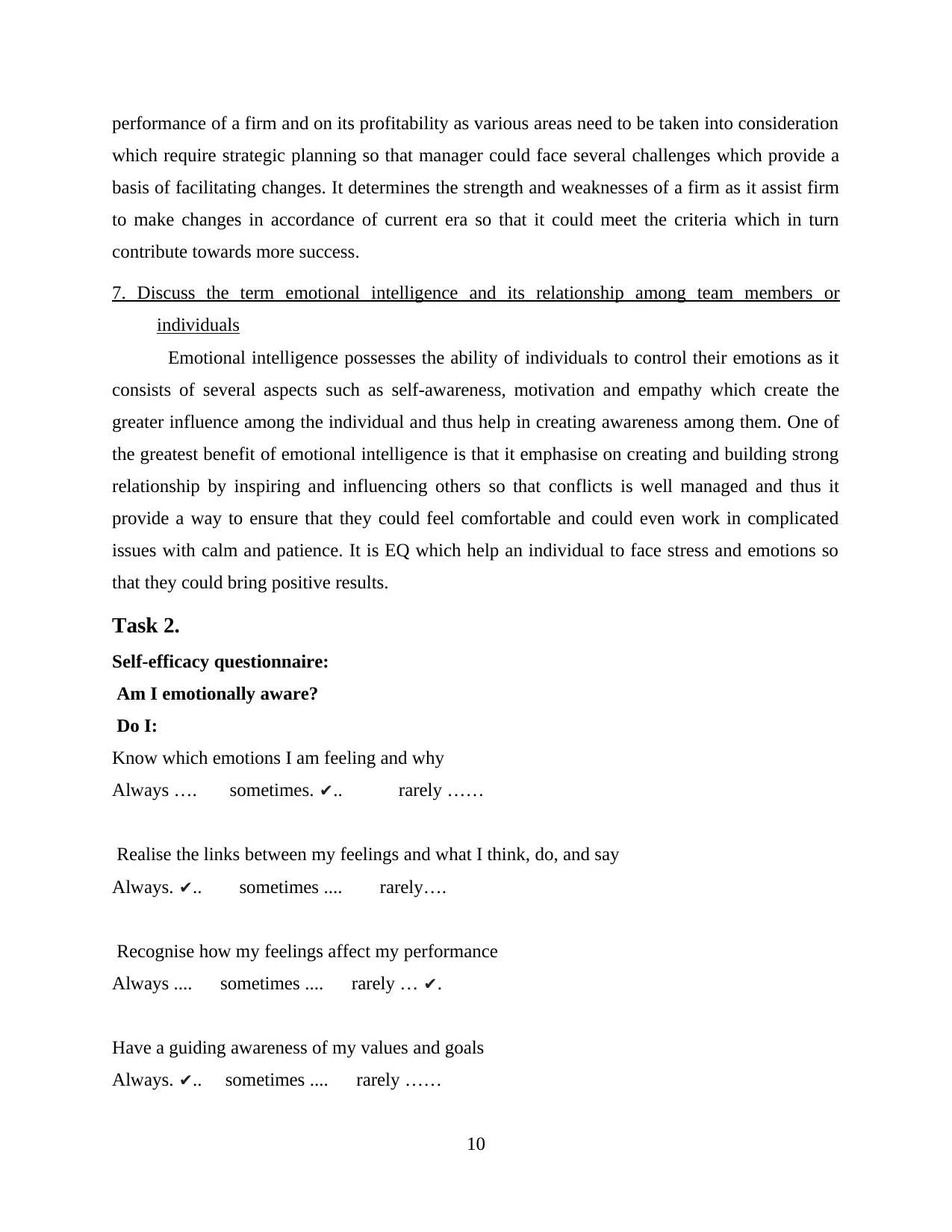
performance of a firm and on its profitability as various areas need to be taken into consideration
which require strategic planning so that manager could face several challenges which provide a
basis of facilitating changes. It determines the strength and weaknesses of a firm as it assist firm
to make changes in accordance of current era so that it could meet the criteria which in turn
contribute towards more success.
7. Discuss the term emotional intelligence and its relationship among team members or
individuals
Emotional intelligence possesses the ability of individuals to control their emotions as it
consists of several aspects such as self-awareness, motivation and empathy which create the
greater influence among the individual and thus help in creating awareness among them. One of
the greatest benefit of emotional intelligence is that it emphasise on creating and building strong
relationship by inspiring and influencing others so that conflicts is well managed and thus it
provide a way to ensure that they could feel comfortable and could even work in complicated
issues with calm and patience. It is EQ which help an individual to face stress and emotions so
that they could bring positive results.
Task 2.
Self-efficacy questionnaire:
Am I emotionally aware?
Do I:
Know which emotions I am feeling and why
Always …. sometimes. ✔.. rarely ……
Realise the links between my feelings and what I think, do, and say
Always. ✔.. sometimes .... rarely….
Recognise how my feelings affect my performance
Always .... sometimes .... rarely … ✔.
Have a guiding awareness of my values and goals
Always. ✔.. sometimes .... rarely ……
10
which require strategic planning so that manager could face several challenges which provide a
basis of facilitating changes. It determines the strength and weaknesses of a firm as it assist firm
to make changes in accordance of current era so that it could meet the criteria which in turn
contribute towards more success.
7. Discuss the term emotional intelligence and its relationship among team members or
individuals
Emotional intelligence possesses the ability of individuals to control their emotions as it
consists of several aspects such as self-awareness, motivation and empathy which create the
greater influence among the individual and thus help in creating awareness among them. One of
the greatest benefit of emotional intelligence is that it emphasise on creating and building strong
relationship by inspiring and influencing others so that conflicts is well managed and thus it
provide a way to ensure that they could feel comfortable and could even work in complicated
issues with calm and patience. It is EQ which help an individual to face stress and emotions so
that they could bring positive results.
Task 2.
Self-efficacy questionnaire:
Am I emotionally aware?
Do I:
Know which emotions I am feeling and why
Always …. sometimes. ✔.. rarely ……
Realise the links between my feelings and what I think, do, and say
Always. ✔.. sometimes .... rarely….
Recognise how my feelings affect my performance
Always .... sometimes .... rarely … ✔.
Have a guiding awareness of my values and goals
Always. ✔.. sometimes .... rarely ……
10
Paraphrase This Document
Need a fresh take? Get an instant paraphrase of this document with our AI Paraphraser
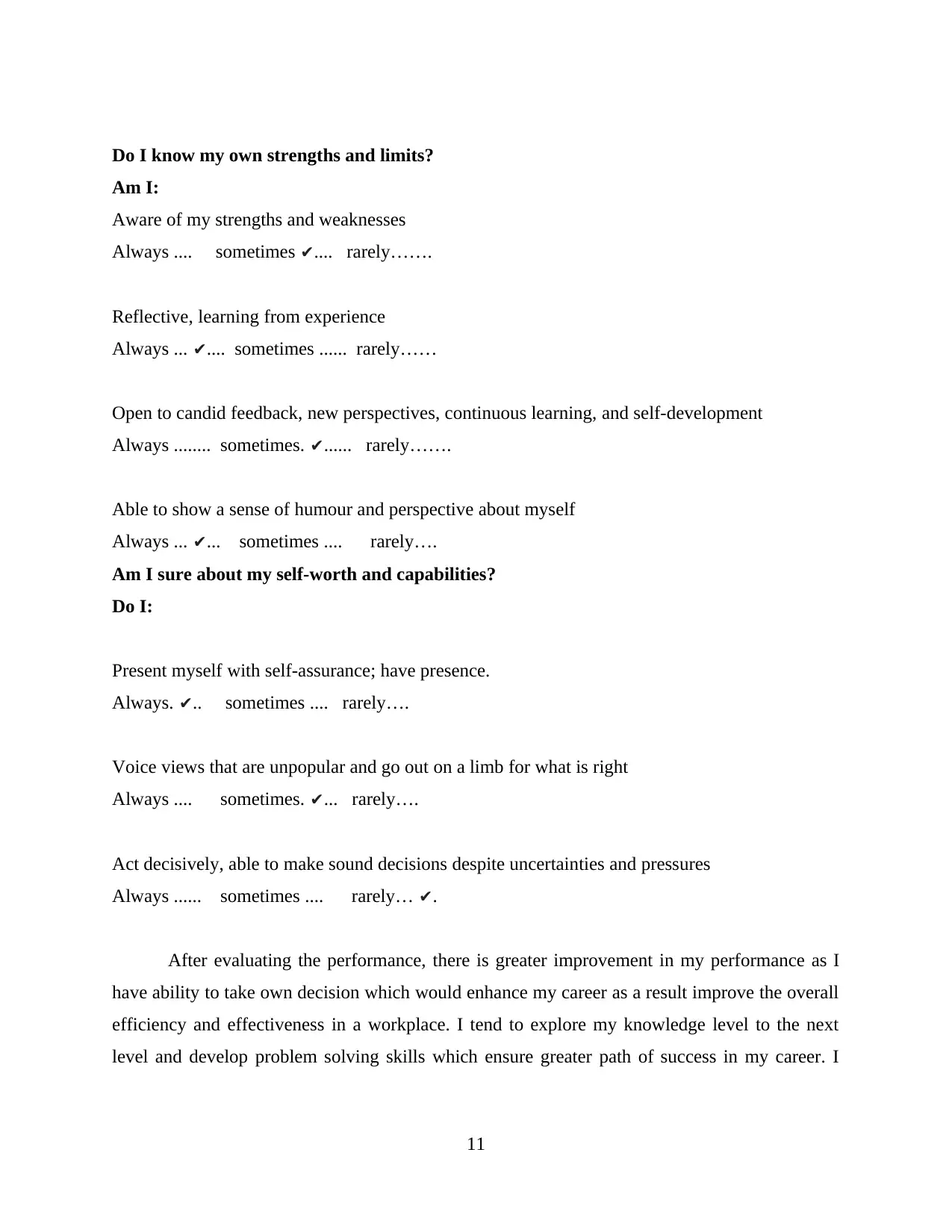
Do I know my own strengths and limits?
Am I:
Aware of my strengths and weaknesses
Always .... sometimes ✔.... rarely…….
Reflective, learning from experience
Always ... ✔.... sometimes ...... rarely……
Open to candid feedback, new perspectives, continuous learning, and self-development
Always ........ sometimes. ✔...... rarely…….
Able to show a sense of humour and perspective about myself
Always ... ✔... sometimes .... rarely….
Am I sure about my self-worth and capabilities?
Do I:
Present myself with self-assurance; have presence.
Always. ✔.. sometimes .... rarely….
Voice views that are unpopular and go out on a limb for what is right
Always .... sometimes. ✔... rarely….
Act decisively, able to make sound decisions despite uncertainties and pressures
Always ...... sometimes .... rarely… ✔.
After evaluating the performance, there is greater improvement in my performance as I
have ability to take own decision which would enhance my career as a result improve the overall
efficiency and effectiveness in a workplace. I tend to explore my knowledge level to the next
level and develop problem solving skills which ensure greater path of success in my career. I
11
Am I:
Aware of my strengths and weaknesses
Always .... sometimes ✔.... rarely…….
Reflective, learning from experience
Always ... ✔.... sometimes ...... rarely……
Open to candid feedback, new perspectives, continuous learning, and self-development
Always ........ sometimes. ✔...... rarely…….
Able to show a sense of humour and perspective about myself
Always ... ✔... sometimes .... rarely….
Am I sure about my self-worth and capabilities?
Do I:
Present myself with self-assurance; have presence.
Always. ✔.. sometimes .... rarely….
Voice views that are unpopular and go out on a limb for what is right
Always .... sometimes. ✔... rarely….
Act decisively, able to make sound decisions despite uncertainties and pressures
Always ...... sometimes .... rarely… ✔.
After evaluating the performance, there is greater improvement in my performance as I
have ability to take own decision which would enhance my career as a result improve the overall
efficiency and effectiveness in a workplace. I tend to explore my knowledge level to the next
level and develop problem solving skills which ensure greater path of success in my career. I
11
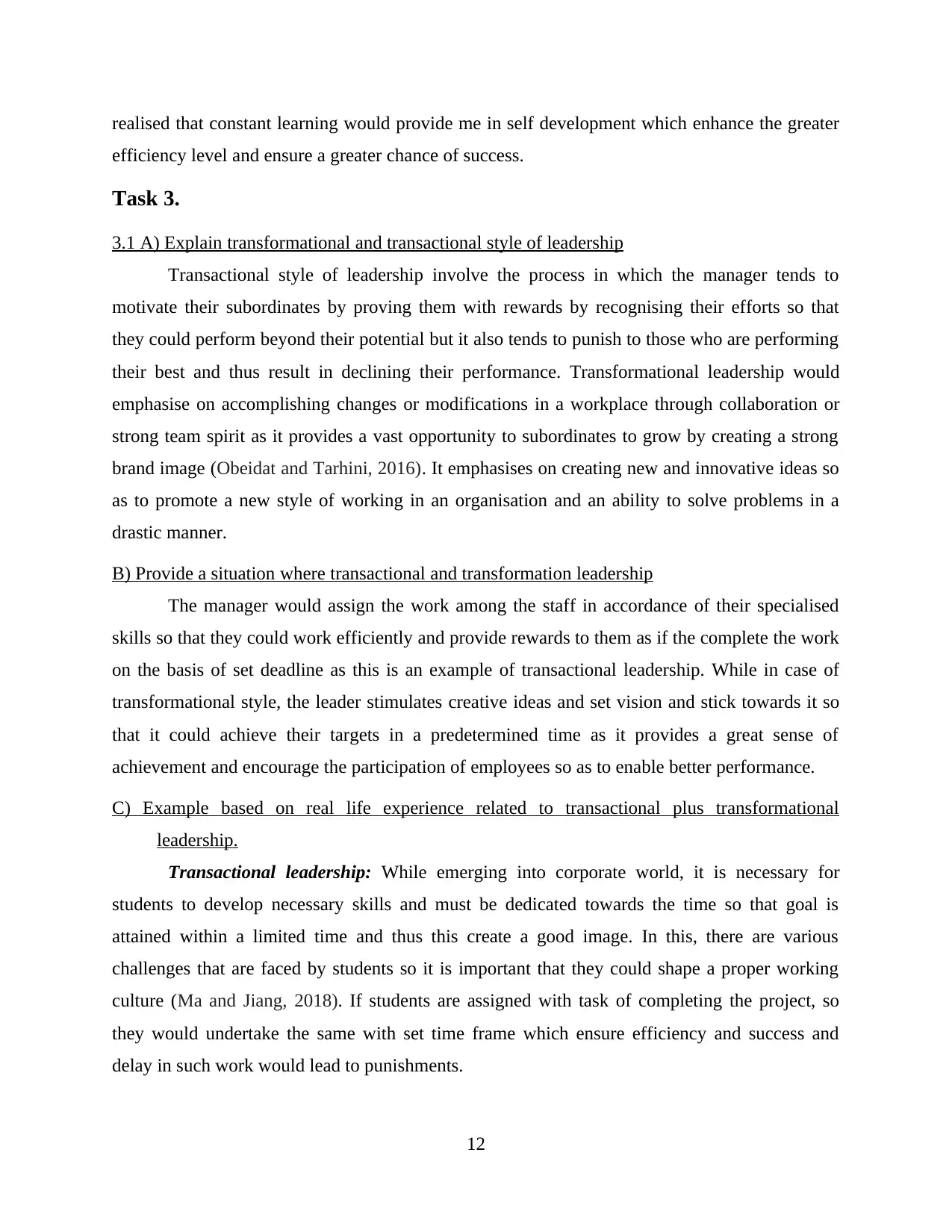
realised that constant learning would provide me in self development which enhance the greater
efficiency level and ensure a greater chance of success.
Task 3.
3.1 A) Explain transformational and transactional style of leadership
Transactional style of leadership involve the process in which the manager tends to
motivate their subordinates by proving them with rewards by recognising their efforts so that
they could perform beyond their potential but it also tends to punish to those who are performing
their best and thus result in declining their performance. Transformational leadership would
emphasise on accomplishing changes or modifications in a workplace through collaboration or
strong team spirit as it provides a vast opportunity to subordinates to grow by creating a strong
brand image (Obeidat and Tarhini, 2016). It emphasises on creating new and innovative ideas so
as to promote a new style of working in an organisation and an ability to solve problems in a
drastic manner.
B) Provide a situation where transactional and transformation leadership
The manager would assign the work among the staff in accordance of their specialised
skills so that they could work efficiently and provide rewards to them as if the complete the work
on the basis of set deadline as this is an example of transactional leadership. While in case of
transformational style, the leader stimulates creative ideas and set vision and stick towards it so
that it could achieve their targets in a predetermined time as it provides a great sense of
achievement and encourage the participation of employees so as to enable better performance.
C) Example based on real life experience related to transactional plus transformational
leadership.
Transactional leadership: While emerging into corporate world, it is necessary for
students to develop necessary skills and must be dedicated towards the time so that goal is
attained within a limited time and thus this create a good image. In this, there are various
challenges that are faced by students so it is important that they could shape a proper working
culture (Ma and Jiang, 2018). If students are assigned with task of completing the project, so
they would undertake the same with set time frame which ensure efficiency and success and
delay in such work would lead to punishments.
12
efficiency level and ensure a greater chance of success.
Task 3.
3.1 A) Explain transformational and transactional style of leadership
Transactional style of leadership involve the process in which the manager tends to
motivate their subordinates by proving them with rewards by recognising their efforts so that
they could perform beyond their potential but it also tends to punish to those who are performing
their best and thus result in declining their performance. Transformational leadership would
emphasise on accomplishing changes or modifications in a workplace through collaboration or
strong team spirit as it provides a vast opportunity to subordinates to grow by creating a strong
brand image (Obeidat and Tarhini, 2016). It emphasises on creating new and innovative ideas so
as to promote a new style of working in an organisation and an ability to solve problems in a
drastic manner.
B) Provide a situation where transactional and transformation leadership
The manager would assign the work among the staff in accordance of their specialised
skills so that they could work efficiently and provide rewards to them as if the complete the work
on the basis of set deadline as this is an example of transactional leadership. While in case of
transformational style, the leader stimulates creative ideas and set vision and stick towards it so
that it could achieve their targets in a predetermined time as it provides a great sense of
achievement and encourage the participation of employees so as to enable better performance.
C) Example based on real life experience related to transactional plus transformational
leadership.
Transactional leadership: While emerging into corporate world, it is necessary for
students to develop necessary skills and must be dedicated towards the time so that goal is
attained within a limited time and thus this create a good image. In this, there are various
challenges that are faced by students so it is important that they could shape a proper working
culture (Ma and Jiang, 2018). If students are assigned with task of completing the project, so
they would undertake the same with set time frame which ensure efficiency and success and
delay in such work would lead to punishments.
12
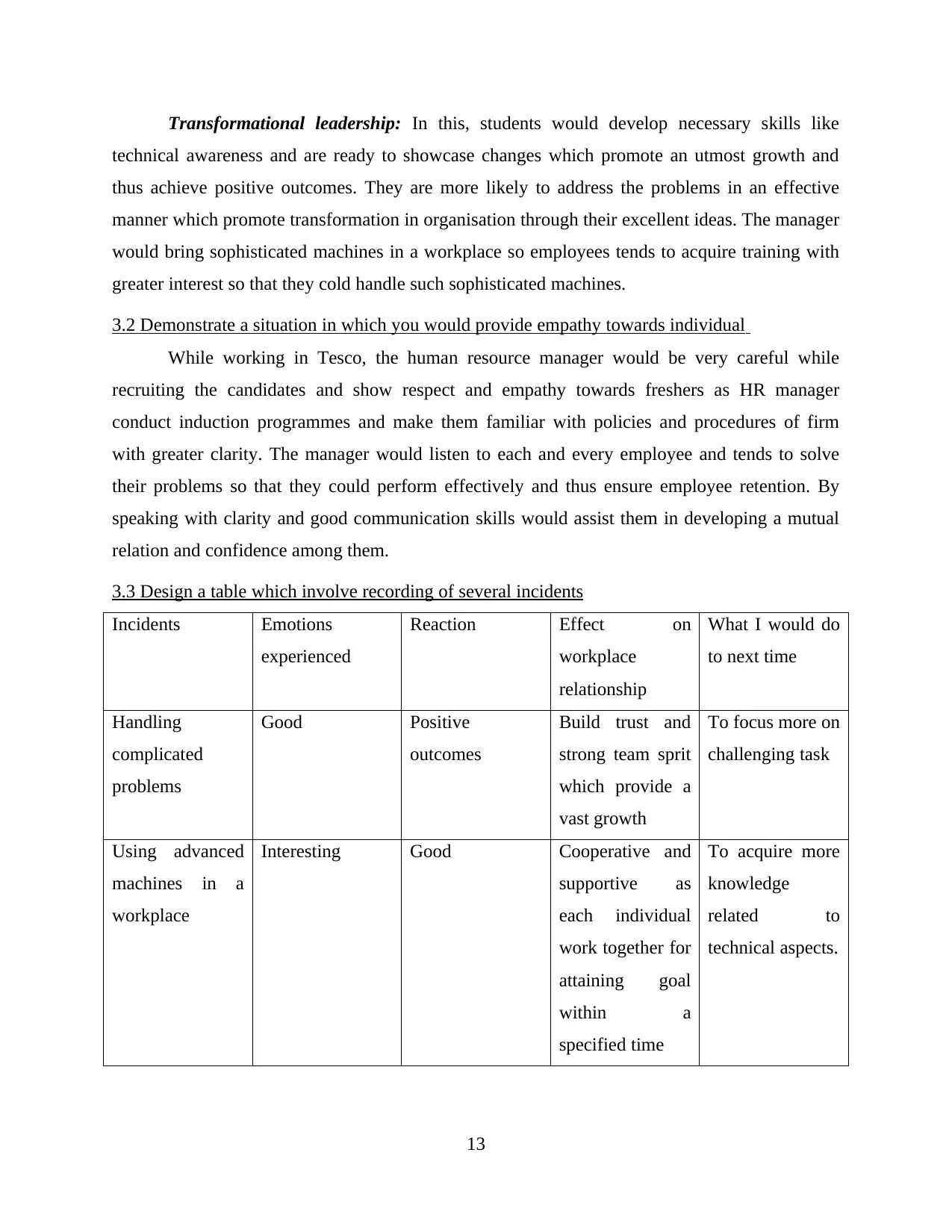
Transformational leadership: In this, students would develop necessary skills like
technical awareness and are ready to showcase changes which promote an utmost growth and
thus achieve positive outcomes. They are more likely to address the problems in an effective
manner which promote transformation in organisation through their excellent ideas. The manager
would bring sophisticated machines in a workplace so employees tends to acquire training with
greater interest so that they cold handle such sophisticated machines.
3.2 Demonstrate a situation in which you would provide empathy towards individual
While working in Tesco, the human resource manager would be very careful while
recruiting the candidates and show respect and empathy towards freshers as HR manager
conduct induction programmes and make them familiar with policies and procedures of firm
with greater clarity. The manager would listen to each and every employee and tends to solve
their problems so that they could perform effectively and thus ensure employee retention. By
speaking with clarity and good communication skills would assist them in developing a mutual
relation and confidence among them.
3.3 Design a table which involve recording of several incidents
Incidents Emotions
experienced
Reaction Effect on
workplace
relationship
What I would do
to next time
Handling
complicated
problems
Good Positive
outcomes
Build trust and
strong team sprit
which provide a
vast growth
To focus more on
challenging task
Using advanced
machines in a
workplace
Interesting Good Cooperative and
supportive as
each individual
work together for
attaining goal
within a
specified time
To acquire more
knowledge
related to
technical aspects.
13
technical awareness and are ready to showcase changes which promote an utmost growth and
thus achieve positive outcomes. They are more likely to address the problems in an effective
manner which promote transformation in organisation through their excellent ideas. The manager
would bring sophisticated machines in a workplace so employees tends to acquire training with
greater interest so that they cold handle such sophisticated machines.
3.2 Demonstrate a situation in which you would provide empathy towards individual
While working in Tesco, the human resource manager would be very careful while
recruiting the candidates and show respect and empathy towards freshers as HR manager
conduct induction programmes and make them familiar with policies and procedures of firm
with greater clarity. The manager would listen to each and every employee and tends to solve
their problems so that they could perform effectively and thus ensure employee retention. By
speaking with clarity and good communication skills would assist them in developing a mutual
relation and confidence among them.
3.3 Design a table which involve recording of several incidents
Incidents Emotions
experienced
Reaction Effect on
workplace
relationship
What I would do
to next time
Handling
complicated
problems
Good Positive
outcomes
Build trust and
strong team sprit
which provide a
vast growth
To focus more on
challenging task
Using advanced
machines in a
workplace
Interesting Good Cooperative and
supportive as
each individual
work together for
attaining goal
within a
specified time
To acquire more
knowledge
related to
technical aspects.
13
Secure Best Marks with AI Grader
Need help grading? Try our AI Grader for instant feedback on your assignments.
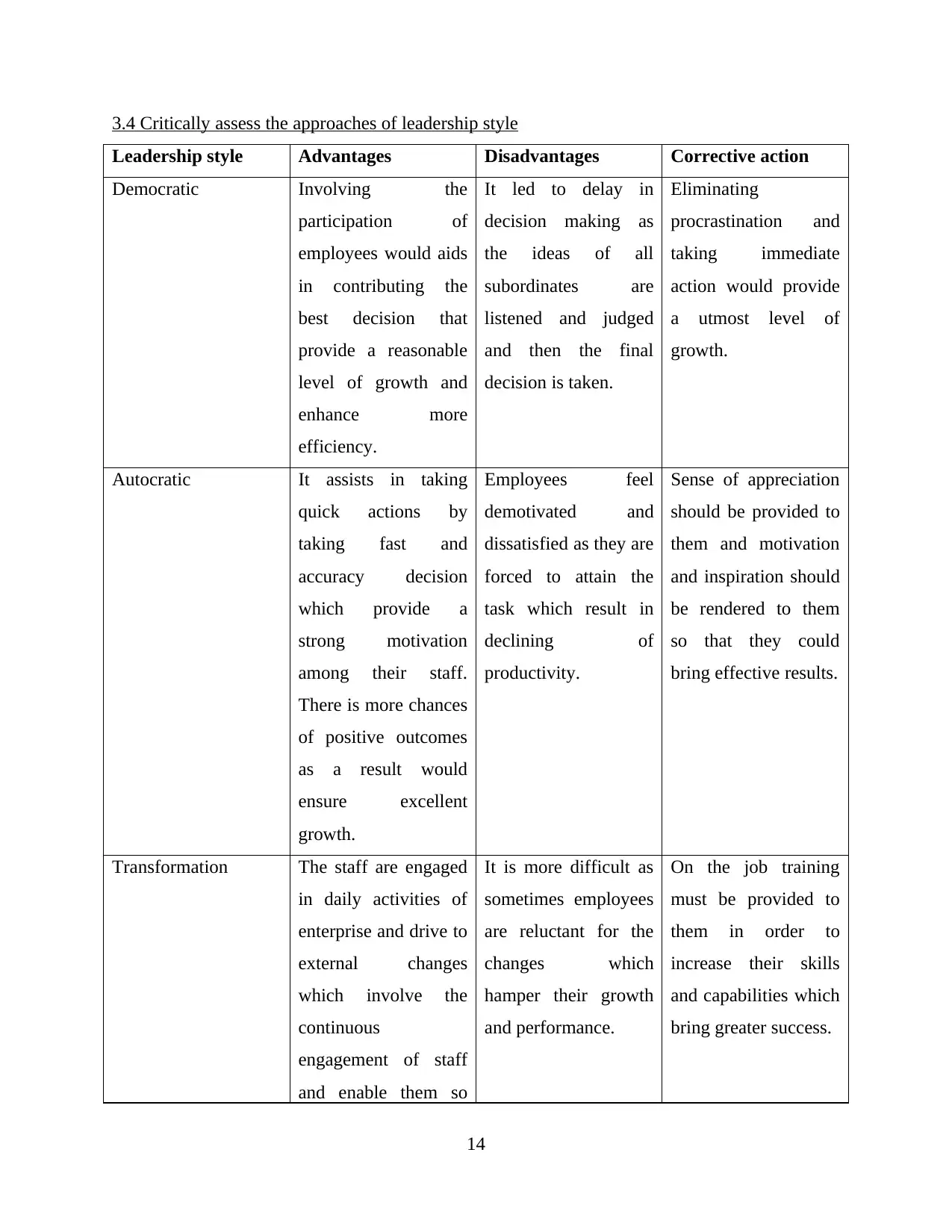
3.4 Critically assess the approaches of leadership style
Leadership style Advantages Disadvantages Corrective action
Democratic Involving the
participation of
employees would aids
in contributing the
best decision that
provide a reasonable
level of growth and
enhance more
efficiency.
It led to delay in
decision making as
the ideas of all
subordinates are
listened and judged
and then the final
decision is taken.
Eliminating
procrastination and
taking immediate
action would provide
a utmost level of
growth.
Autocratic It assists in taking
quick actions by
taking fast and
accuracy decision
which provide a
strong motivation
among their staff.
There is more chances
of positive outcomes
as a result would
ensure excellent
growth.
Employees feel
demotivated and
dissatisfied as they are
forced to attain the
task which result in
declining of
productivity.
Sense of appreciation
should be provided to
them and motivation
and inspiration should
be rendered to them
so that they could
bring effective results.
Transformation The staff are engaged
in daily activities of
enterprise and drive to
external changes
which involve the
continuous
engagement of staff
and enable them so
It is more difficult as
sometimes employees
are reluctant for the
changes which
hamper their growth
and performance.
On the job training
must be provided to
them in order to
increase their skills
and capabilities which
bring greater success.
14
Leadership style Advantages Disadvantages Corrective action
Democratic Involving the
participation of
employees would aids
in contributing the
best decision that
provide a reasonable
level of growth and
enhance more
efficiency.
It led to delay in
decision making as
the ideas of all
subordinates are
listened and judged
and then the final
decision is taken.
Eliminating
procrastination and
taking immediate
action would provide
a utmost level of
growth.
Autocratic It assists in taking
quick actions by
taking fast and
accuracy decision
which provide a
strong motivation
among their staff.
There is more chances
of positive outcomes
as a result would
ensure excellent
growth.
Employees feel
demotivated and
dissatisfied as they are
forced to attain the
task which result in
declining of
productivity.
Sense of appreciation
should be provided to
them and motivation
and inspiration should
be rendered to them
so that they could
bring effective results.
Transformation The staff are engaged
in daily activities of
enterprise and drive to
external changes
which involve the
continuous
engagement of staff
and enable them so
It is more difficult as
sometimes employees
are reluctant for the
changes which
hamper their growth
and performance.
On the job training
must be provided to
them in order to
increase their skills
and capabilities which
bring greater success.
14
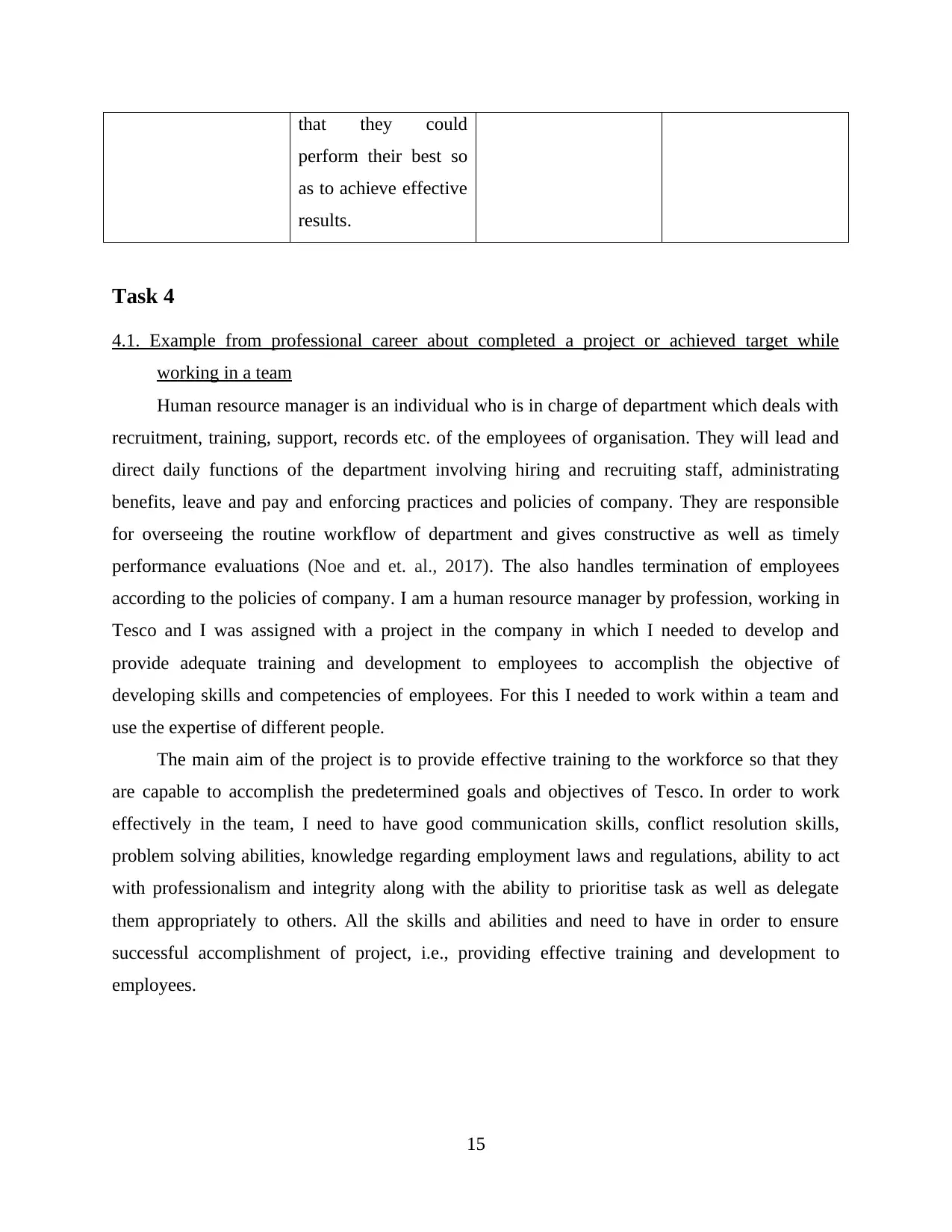
that they could
perform their best so
as to achieve effective
results.
Task 4
4.1. Example from professional career about completed a project or achieved target while
working in a team
Human resource manager is an individual who is in charge of department which deals with
recruitment, training, support, records etc. of the employees of organisation. They will lead and
direct daily functions of the department involving hiring and recruiting staff, administrating
benefits, leave and pay and enforcing practices and policies of company. They are responsible
for overseeing the routine workflow of department and gives constructive as well as timely
performance evaluations (Noe and et. al., 2017). The also handles termination of employees
according to the policies of company. I am a human resource manager by profession, working in
Tesco and I was assigned with a project in the company in which I needed to develop and
provide adequate training and development to employees to accomplish the objective of
developing skills and competencies of employees. For this I needed to work within a team and
use the expertise of different people.
The main aim of the project is to provide effective training to the workforce so that they
are capable to accomplish the predetermined goals and objectives of Tesco. In order to work
effectively in the team, I need to have good communication skills, conflict resolution skills,
problem solving abilities, knowledge regarding employment laws and regulations, ability to act
with professionalism and integrity along with the ability to prioritise task as well as delegate
them appropriately to others. All the skills and abilities and need to have in order to ensure
successful accomplishment of project, i.e., providing effective training and development to
employees.
15
perform their best so
as to achieve effective
results.
Task 4
4.1. Example from professional career about completed a project or achieved target while
working in a team
Human resource manager is an individual who is in charge of department which deals with
recruitment, training, support, records etc. of the employees of organisation. They will lead and
direct daily functions of the department involving hiring and recruiting staff, administrating
benefits, leave and pay and enforcing practices and policies of company. They are responsible
for overseeing the routine workflow of department and gives constructive as well as timely
performance evaluations (Noe and et. al., 2017). The also handles termination of employees
according to the policies of company. I am a human resource manager by profession, working in
Tesco and I was assigned with a project in the company in which I needed to develop and
provide adequate training and development to employees to accomplish the objective of
developing skills and competencies of employees. For this I needed to work within a team and
use the expertise of different people.
The main aim of the project is to provide effective training to the workforce so that they
are capable to accomplish the predetermined goals and objectives of Tesco. In order to work
effectively in the team, I need to have good communication skills, conflict resolution skills,
problem solving abilities, knowledge regarding employment laws and regulations, ability to act
with professionalism and integrity along with the ability to prioritise task as well as delegate
them appropriately to others. All the skills and abilities and need to have in order to ensure
successful accomplishment of project, i.e., providing effective training and development to
employees.
15
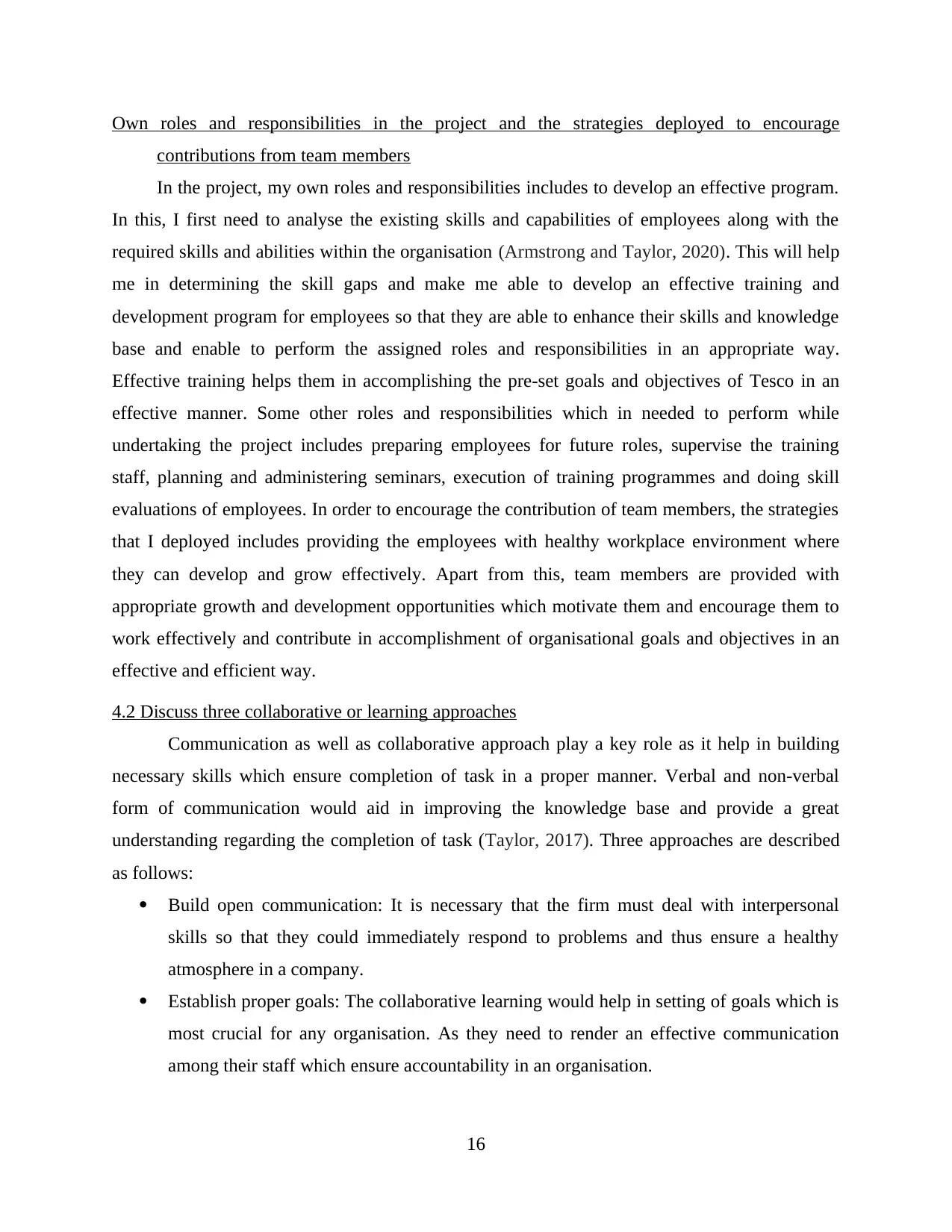
Own roles and responsibilities in the project and the strategies deployed to encourage
contributions from team members
In the project, my own roles and responsibilities includes to develop an effective program.
In this, I first need to analyse the existing skills and capabilities of employees along with the
required skills and abilities within the organisation (Armstrong and Taylor, 2020). This will help
me in determining the skill gaps and make me able to develop an effective training and
development program for employees so that they are able to enhance their skills and knowledge
base and enable to perform the assigned roles and responsibilities in an appropriate way.
Effective training helps them in accomplishing the pre-set goals and objectives of Tesco in an
effective manner. Some other roles and responsibilities which in needed to perform while
undertaking the project includes preparing employees for future roles, supervise the training
staff, planning and administering seminars, execution of training programmes and doing skill
evaluations of employees. In order to encourage the contribution of team members, the strategies
that I deployed includes providing the employees with healthy workplace environment where
they can develop and grow effectively. Apart from this, team members are provided with
appropriate growth and development opportunities which motivate them and encourage them to
work effectively and contribute in accomplishment of organisational goals and objectives in an
effective and efficient way.
4.2 Discuss three collaborative or learning approaches
Communication as well as collaborative approach play a key role as it help in building
necessary skills which ensure completion of task in a proper manner. Verbal and non-verbal
form of communication would aid in improving the knowledge base and provide a great
understanding regarding the completion of task (Taylor, 2017). Three approaches are described
as follows:
Build open communication: It is necessary that the firm must deal with interpersonal
skills so that they could immediately respond to problems and thus ensure a healthy
atmosphere in a company.
Establish proper goals: The collaborative learning would help in setting of goals which is
most crucial for any organisation. As they need to render an effective communication
among their staff which ensure accountability in an organisation.
16
contributions from team members
In the project, my own roles and responsibilities includes to develop an effective program.
In this, I first need to analyse the existing skills and capabilities of employees along with the
required skills and abilities within the organisation (Armstrong and Taylor, 2020). This will help
me in determining the skill gaps and make me able to develop an effective training and
development program for employees so that they are able to enhance their skills and knowledge
base and enable to perform the assigned roles and responsibilities in an appropriate way.
Effective training helps them in accomplishing the pre-set goals and objectives of Tesco in an
effective manner. Some other roles and responsibilities which in needed to perform while
undertaking the project includes preparing employees for future roles, supervise the training
staff, planning and administering seminars, execution of training programmes and doing skill
evaluations of employees. In order to encourage the contribution of team members, the strategies
that I deployed includes providing the employees with healthy workplace environment where
they can develop and grow effectively. Apart from this, team members are provided with
appropriate growth and development opportunities which motivate them and encourage them to
work effectively and contribute in accomplishment of organisational goals and objectives in an
effective and efficient way.
4.2 Discuss three collaborative or learning approaches
Communication as well as collaborative approach play a key role as it help in building
necessary skills which ensure completion of task in a proper manner. Verbal and non-verbal
form of communication would aid in improving the knowledge base and provide a great
understanding regarding the completion of task (Taylor, 2017). Three approaches are described
as follows:
Build open communication: It is necessary that the firm must deal with interpersonal
skills so that they could immediately respond to problems and thus ensure a healthy
atmosphere in a company.
Establish proper goals: The collaborative learning would help in setting of goals which is
most crucial for any organisation. As they need to render an effective communication
among their staff which ensure accountability in an organisation.
16
Paraphrase This Document
Need a fresh take? Get an instant paraphrase of this document with our AI Paraphraser
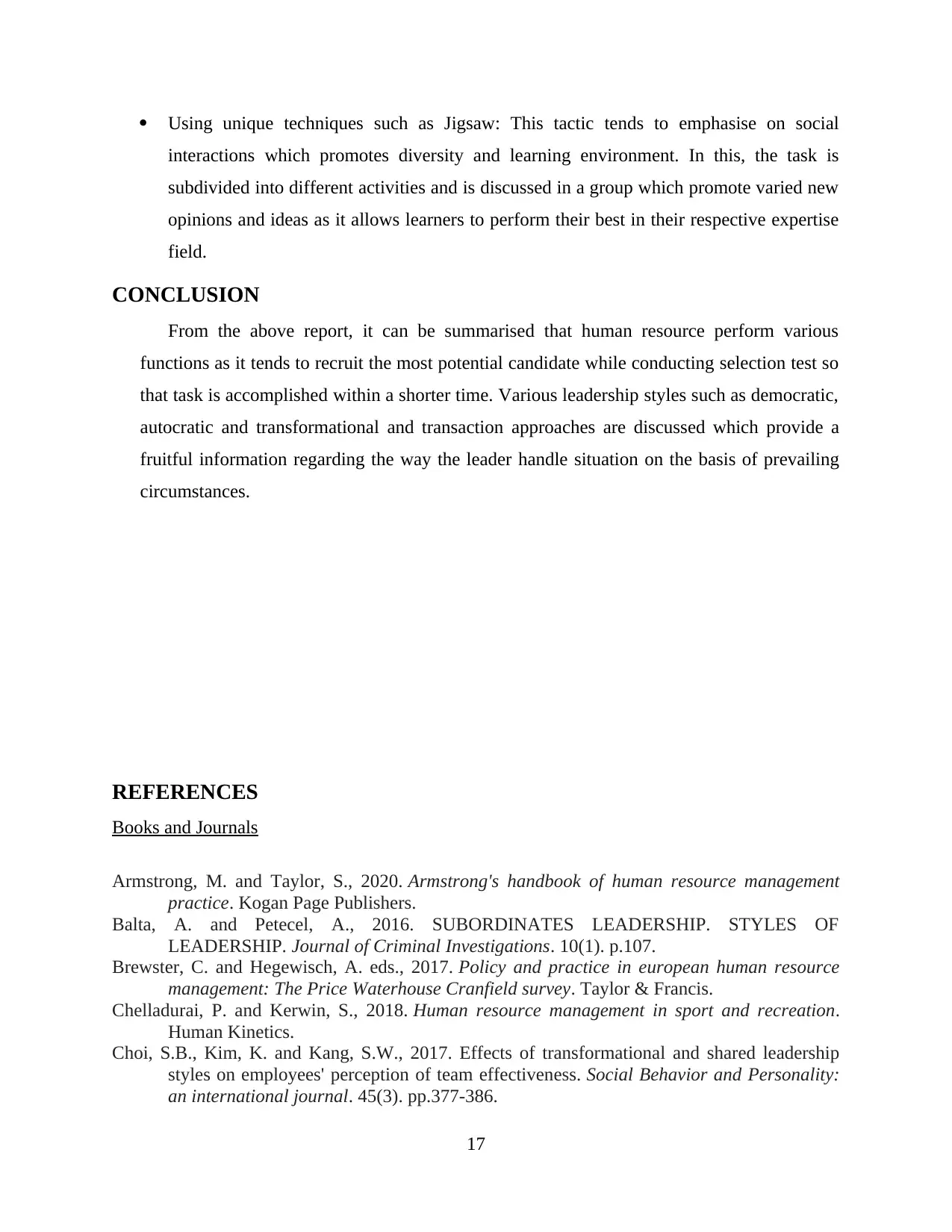
Using unique techniques such as Jigsaw: This tactic tends to emphasise on social
interactions which promotes diversity and learning environment. In this, the task is
subdivided into different activities and is discussed in a group which promote varied new
opinions and ideas as it allows learners to perform their best in their respective expertise
field.
CONCLUSION
From the above report, it can be summarised that human resource perform various
functions as it tends to recruit the most potential candidate while conducting selection test so
that task is accomplished within a shorter time. Various leadership styles such as democratic,
autocratic and transformational and transaction approaches are discussed which provide a
fruitful information regarding the way the leader handle situation on the basis of prevailing
circumstances.
REFERENCES
Books and Journals
Armstrong, M. and Taylor, S., 2020. Armstrong's handbook of human resource management
practice. Kogan Page Publishers.
Balta, A. and Petecel, A., 2016. SUBORDINATES LEADERSHIP. STYLES OF
LEADERSHIP. Journal of Criminal Investigations. 10(1). p.107.
Brewster, C. and Hegewisch, A. eds., 2017. Policy and practice in european human resource
management: The Price Waterhouse Cranfield survey. Taylor & Francis.
Chelladurai, P. and Kerwin, S., 2018. Human resource management in sport and recreation.
Human Kinetics.
Choi, S.B., Kim, K. and Kang, S.W., 2017. Effects of transformational and shared leadership
styles on employees' perception of team effectiveness. Social Behavior and Personality:
an international journal. 45(3). pp.377-386.
17
interactions which promotes diversity and learning environment. In this, the task is
subdivided into different activities and is discussed in a group which promote varied new
opinions and ideas as it allows learners to perform their best in their respective expertise
field.
CONCLUSION
From the above report, it can be summarised that human resource perform various
functions as it tends to recruit the most potential candidate while conducting selection test so
that task is accomplished within a shorter time. Various leadership styles such as democratic,
autocratic and transformational and transaction approaches are discussed which provide a
fruitful information regarding the way the leader handle situation on the basis of prevailing
circumstances.
REFERENCES
Books and Journals
Armstrong, M. and Taylor, S., 2020. Armstrong's handbook of human resource management
practice. Kogan Page Publishers.
Balta, A. and Petecel, A., 2016. SUBORDINATES LEADERSHIP. STYLES OF
LEADERSHIP. Journal of Criminal Investigations. 10(1). p.107.
Brewster, C. and Hegewisch, A. eds., 2017. Policy and practice in european human resource
management: The Price Waterhouse Cranfield survey. Taylor & Francis.
Chelladurai, P. and Kerwin, S., 2018. Human resource management in sport and recreation.
Human Kinetics.
Choi, S.B., Kim, K. and Kang, S.W., 2017. Effects of transformational and shared leadership
styles on employees' perception of team effectiveness. Social Behavior and Personality:
an international journal. 45(3). pp.377-386.
17
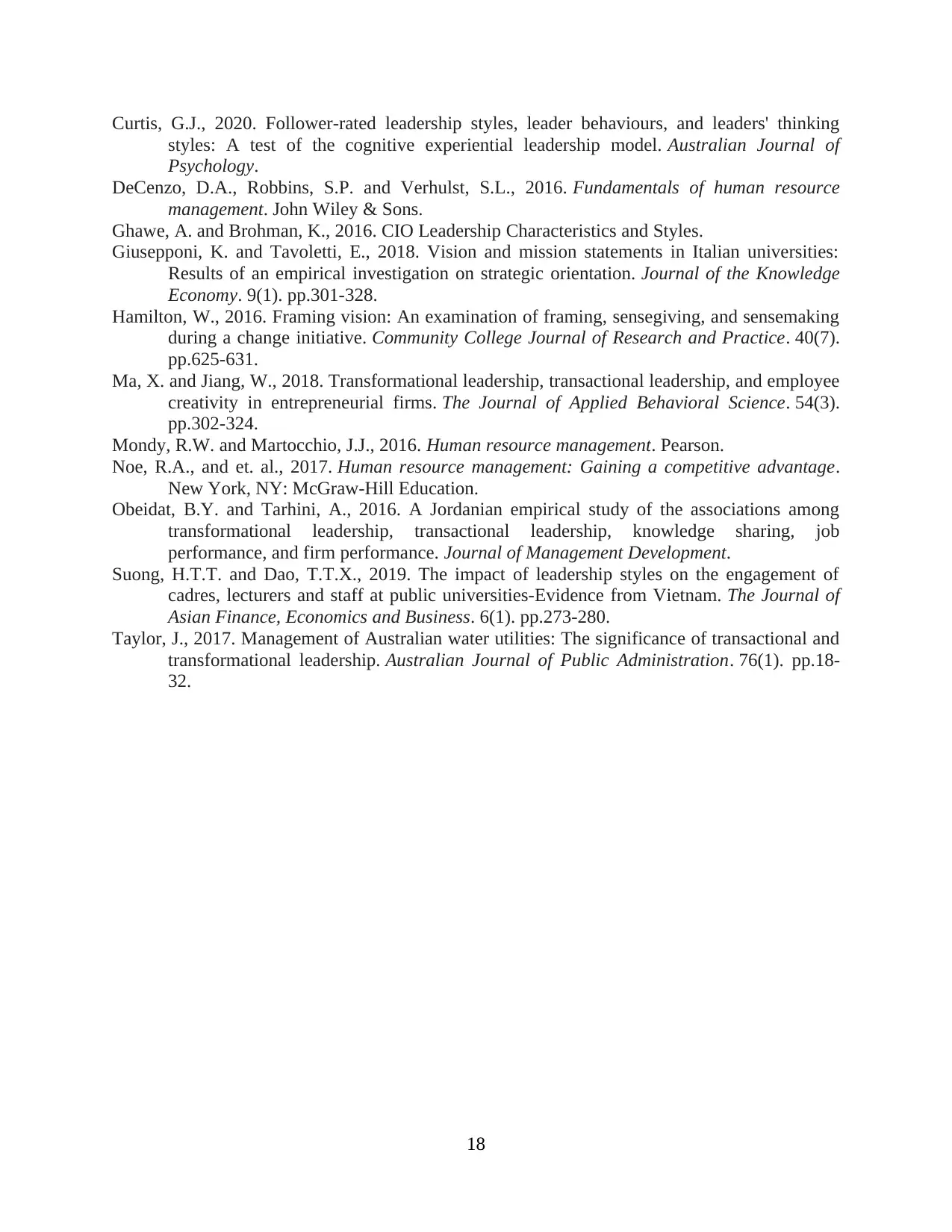
Curtis, G.J., 2020. Follower‐rated leadership styles, leader behaviours, and leaders' thinking
styles: A test of the cognitive experiential leadership model. Australian Journal of
Psychology.
DeCenzo, D.A., Robbins, S.P. and Verhulst, S.L., 2016. Fundamentals of human resource
management. John Wiley & Sons.
Ghawe, A. and Brohman, K., 2016. CIO Leadership Characteristics and Styles.
Giusepponi, K. and Tavoletti, E., 2018. Vision and mission statements in Italian universities:
Results of an empirical investigation on strategic orientation. Journal of the Knowledge
Economy. 9(1). pp.301-328.
Hamilton, W., 2016. Framing vision: An examination of framing, sensegiving, and sensemaking
during a change initiative. Community College Journal of Research and Practice. 40(7).
pp.625-631.
Ma, X. and Jiang, W., 2018. Transformational leadership, transactional leadership, and employee
creativity in entrepreneurial firms. The Journal of Applied Behavioral Science. 54(3).
pp.302-324.
Mondy, R.W. and Martocchio, J.J., 2016. Human resource management. Pearson.
Noe, R.A., and et. al., 2017. Human resource management: Gaining a competitive advantage.
New York, NY: McGraw-Hill Education.
Obeidat, B.Y. and Tarhini, A., 2016. A Jordanian empirical study of the associations among
transformational leadership, transactional leadership, knowledge sharing, job
performance, and firm performance. Journal of Management Development.
Suong, H.T.T. and Dao, T.T.X., 2019. The impact of leadership styles on the engagement of
cadres, lecturers and staff at public universities-Evidence from Vietnam. The Journal of
Asian Finance, Economics and Business. 6(1). pp.273-280.
Taylor, J., 2017. Management of Australian water utilities: The significance of transactional and
transformational leadership. Australian Journal of Public Administration. 76(1). pp.18-
32.
18
styles: A test of the cognitive experiential leadership model. Australian Journal of
Psychology.
DeCenzo, D.A., Robbins, S.P. and Verhulst, S.L., 2016. Fundamentals of human resource
management. John Wiley & Sons.
Ghawe, A. and Brohman, K., 2016. CIO Leadership Characteristics and Styles.
Giusepponi, K. and Tavoletti, E., 2018. Vision and mission statements in Italian universities:
Results of an empirical investigation on strategic orientation. Journal of the Knowledge
Economy. 9(1). pp.301-328.
Hamilton, W., 2016. Framing vision: An examination of framing, sensegiving, and sensemaking
during a change initiative. Community College Journal of Research and Practice. 40(7).
pp.625-631.
Ma, X. and Jiang, W., 2018. Transformational leadership, transactional leadership, and employee
creativity in entrepreneurial firms. The Journal of Applied Behavioral Science. 54(3).
pp.302-324.
Mondy, R.W. and Martocchio, J.J., 2016. Human resource management. Pearson.
Noe, R.A., and et. al., 2017. Human resource management: Gaining a competitive advantage.
New York, NY: McGraw-Hill Education.
Obeidat, B.Y. and Tarhini, A., 2016. A Jordanian empirical study of the associations among
transformational leadership, transactional leadership, knowledge sharing, job
performance, and firm performance. Journal of Management Development.
Suong, H.T.T. and Dao, T.T.X., 2019. The impact of leadership styles on the engagement of
cadres, lecturers and staff at public universities-Evidence from Vietnam. The Journal of
Asian Finance, Economics and Business. 6(1). pp.273-280.
Taylor, J., 2017. Management of Australian water utilities: The significance of transactional and
transformational leadership. Australian Journal of Public Administration. 76(1). pp.18-
32.
18
1 out of 18
![[object Object]](/_next/static/media/star-bottom.7253800d.svg)





